RELATED LINKS
On this page, london bus maps (pdf), public transport london, fares & payments, london airport transfers, cruise port transfers, travel to / from london, most popular tours.

- Guide to hotel areas
- Bed & breakfast
- Backpacker hostels
- Airbnb London
- Central London tours
- Tours from London
- Harry Potter tours
- Stonehenge tours
- Downton Abbey tours
- Windsor tours
- Cotswolds tours
- Private tours
- Ticket & pass offers
- Central London attractions
- Attractions outside London
- Harry Potter attractions
- Tower of London
- PUBLIC TRANSPORT
- London City
- London Southend
- Southampton

London Underground - 2024 fares and how to use them
Be informed and in control using london's underground / metro system.
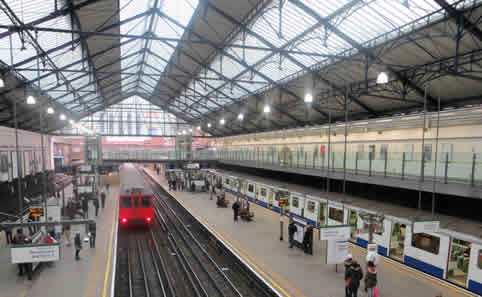
For the visitor to London the Underground or Tube will probably be the transport of choice to get around town. The Underground is normally the fastest way to get around town, often much faster than any taxi.
There is invariably an underground station nearby where you want to go and also your hotel and finding your way around the system is very easy.
There are currently 13 Underground lines, with the Elizabeth Line the latest, which opened in May 2022.
Journey planner Map DLR, overground & TfL Oyster card, contactless & Travelcards Night service Fares Concessions Child fares Group tickets Purchasing tickets Access

Key points about the London Underground
It is still encouraged to wear a facemask when using public transport in London, but it is no longer mandatory.
The authorities penalise you heavily for buying single journey tickets. In the centre you can pay more than double the price than if you used an Oyster Card for example.
A single journey on the London Underground can involve 1 or 2 changes of train. Your journey starts when you go through the ticket barrier of the station entrance you depart from and finishes when you pass through the ticket barrier at the exit of your destination. You cannot break a journey on a single fare, once you go though an exit barrier of a station that is journey completed.
The buses, Underground, DLR and London suburban trains are managed by a central government body called Transport for London (TfL) chaired by the Mayor of London. The transport passes that nearly everyone uses, Oyster and Travelcard, allow you to travel seamlessly across all modes of transport, bus, Underground, train and DLR using the same ticket/pass.
Children under 11 travel free on the London Underground and DLR (Docklands Light Railway) at all times. Child fares are available for those under 16 and it is possible to get discounted fares if you are under 18 or studying in London with an ID card.
There are no seniors fares for visitors. If you reside in London and are over 60 you can get a pass that makes free bus and Underground travel available. If you have an English National Concessionary bus pass you cannot use it on the London Underground (but you can use it on London's red buses).
The London Underground is closed from around midnight until around 5am, getting started a little later on Sundays. However on Friday and Saturday nights, much of the Underground runs through the night. In Central London there is a very good night bus network when the Underground is closed.
You will rarely have to wait more than 5 minutes for an Underground train at any time of the day.
London Journey Planner - for all types of transport across London
Use the TfL (Transport for London) journey planner to plan your travel. The journey planner covers all public transport.
TFL Journey planner

London Underground map
The London Underground map is a classic design that when first launched was immediately taken up worldwide for similar systems. The clarity, simplicity and ease of use compromises strict geographical accuracy.
The Circle line doesn't really go around in a squashed circle and it is not apparent for instance that Bayswater Underground is only 100 yards from Queensway.
In 2016 the Night Tube was introduced. On Friday and Saturday nights only Underground trains run through the night. For lines that operate a night service see the Night Tube map linked below or on the right-menu.
In May 2022 the long awaited Elizabeth Line opened its first section. The Elizabeth Line provides a route connecting East and West London. Find out more about the new Elizabeth Line .
Underground map Tube & rail map Night tube map
Docklands Light Railway (DLR), overground and TfL rail trains
To the east of London in the Docklands region you will see a region covered by something called the DLR (Docklands Light Railway). You can treat this network as just another Underground line.
Not in the centre of London, but in the suburbs you will find a train network called the Overground which can also be thought of as being part of the Underground for ticketing purposes.
Commuter trains into the suburbs are very confusing for the visitor. You can still use Oysters and Travelcards on these but those lines run by the national railways only give free travel to children under 5.
In the north and east of London most of these services are now run by TfL Rail or the Overground so free travel is available to children under 11, but to the south and west of London, services are still dominated by national railways companies.
The Tube and rail map usefully shows which railway stations are in which travel zones. Travel zones are the basis for fare charges on London's railways and Underground system.
London Underground Night Service - the Night Tube
In 2016 the London Underground began to introduce a full 24/7 service on Friday and Saturday nights only. Introduction has been on a phased basis.
Night Tube services are now running on the Central, Victoria, Jubilee line, Northern line (Charing Cross branch) and Piccadilly line (but not Acton to Uxbridge branch). The Night Tube will offer a 24-hour service on Fridays and Saturdays. Standard off-peak fares are levied for travelling on the Night Tube using Oyster and Contactless cards.
Travelcards are valid from the first day of issue (using the date printed on the card), and for journeys starting before 4.30am the following day. For example, if you buy a 1-day Travelcard at 11am on Friday, you can use it until 4.29 on the following Saturday.
Night Tube map - current lines operated
London Underground fares
The London public transport system is divided up into zones that radiate from the centre. Nearly all the hotels and the main sights are in Zone 1. Heathrow Airport is in Zone 6 and the furthest zone out is Zone 9.
The majority of visitors will only travel in the two most central zones 1 and 2. The Underground Map (link above) has the stations and their zones marked.
Some stations, such as Turnham Green, are in two zones. You use whichever zone for these stations is most beneficial in working out your fare.
Underground fares
You can see from the table below there is big financial incentive not to purchase individual tickets and use an Oyster card or Contactless payment card .
The other main way of paying is purchasing a Travelcard , which is a pass giving you unlimited travel for a set time period. The cost goes up with the coverage of zones required. The more zones you require the more expensive the Travelcard.
London Underground Fares from 3 March 2024 - March 2025
Oyster cards, contactless payment cards & travelcards.
As you can see from the above fare structure the authorities do not want you to buy single tickets, they want you to purchase one of the three payment options, Oyster cards, Contactless payment cards or Travelcards.
The Oyster card is a permanent reusable electronic ticket which is topped up from time to time by its owner. Londoners also have their season tickets loaded onto Oyster cards as well and there are passes for one weekly and monthly durations. All can be loaded onto the one electronic Oyster card.
Contactless cards are standard credit or debit cards that support the contactless payment technology, the total cost of all the journeys that you make in one day is calculated at the end of the day and a single charge is made to your Contactless payment card account.
Unlike the Oyster card the contactless facility has a 7-day cap as well as the Oyster daily cap used by Oyster.
You can use Oyster cards on all of London's public transport, not just the Underground, but buses, overground, DLR, suburban rail services and some river services.
Travelcards are another alternatives. Travelcards are valid on the same modes of transport but are unlimited travel passes for a fixed flat fee. Travelcards are available for 1 and 7 days, 1 month and 1 year durations.
You can purchase and subsequently top up Oyster cards and Travelcards from Underground stations and a wide variety of other outlets throughout London including neighbourhood stores, but not Contactless payment cards.
Oyster cards - more details
Contactless payment cards - more details
Travelcards - more details

Seniors concessions
There are no seniors fares for visitors. If you reside in London and are of pensionable age you can get a Freedom pass giving free travel. If you are 60+ and live in London the Seniors Oyster ID Card that makes free bus travel available. You can apply online or get a form from your local Post Office.
Anybody with an English National Concessionary bus pass can use that on London's red buses too and travel free of charge.
If you have a Senior Railcard you can get your 1/3 discount on off-peak Oyster fares. You have to ask a member of staff to load the concession on to a standard Oyster card (note, not a Visitor Oyster card) at an Underground station after showing your Seniors Card.
If you have a Senior Railcard you can also buy a 1 day off-peak zone 1-6 Travelcard at the discount applied.
Child concessions
This is a very complex subject and is covered in detail in the table below. Generally, a child is defined as under 16 years old, but in the last couple of years it has been possible to get child fares after jumping through a few hoops up to the age of 17.
Children under 11 can travel free on the London Underground, DLR and buses without a ticket. If a child is between 11 and 15 years old, you require an Oyster 11-15 Photocard (which has a fee, see below). This allows 11 to 15 year olds to travel at child fares on the Underground, DLR, Overground and some trains, free on the buses.
If you are a short-term visitor (in London for up to 14 days) with kids between 11-15 you can take advantage of the Young Visitor Discount. This means you can get half price fares on an Oyster card on a temporary basis for your child without going through the hoops and expense of getting an Oyster ID card. You do need to read carefully the rules of this scheme though.
Children's Fare Concessions
Group tickets - 1-day group travelcard for groups of 10 or more.
This ticket is for groups of 10 or more travelling together.
This in scope is the same as a 1-day off-peak Travelcard for zones 1-6 and 1-9 providing unlimited travel on all services after 9.30am Monday to Friday and all day Saturday, Sunday and Bank Holidays.
The pricing is particularly attractive if you have kids in the group and those staying in one of the outer zones, however if you are staying in the centre of London zones 1 to 3 it will be cheaper to purchase individual Oyster cards.
If you are a group of 10 or more then do check out this product.

Purchasing tickets & fares levied
There are no longer manned ticket offices at Underground and DLR stations. All tickets are dispensed by ticket machines in the ticket hall and there will be a member of staff hanging around these.
The same machines will allow you to top up your Oyster cards or see what the balance is on your Oyster card and they will also allow you to cancel your Oyster card and get your deposit and any cash left on the Oyster refunded.
If you prefer talking to people selling the tickets there are Oyster ticket stops. These are many of these and typically are convenience stores or news-stands that sell public transport tickets as a sideline. These outlets will have a sign in their front window.
The fare you pay is set by which zone your departure and destination stations are in. Your journey starts when you go through the ticket barrier of the station entrance you depart from and finishes when you pass through the ticket barrier at the exit of your destination. You cannot break a journey on a single fare, once you go though an exit barrier of a station that is your journey completed.
Access to platform & luggage
To gain access to the platforms, and again to exit a station you have to pass through automatic barriers (pictured). There is always one wide ticket barrier for wheelchairs, pushchairs and people with large suitcases.
If you have a single ticket, the barrier at your destination will not return your ticket. There is a manned side gate by the barriers. If you have a Travelcard you insert the Travelcard into the same slot as for the single tickets, the barrier will check that your Travelcard is valid for both date and zones travelled.
If you have an Oyster card or Contactless payment card you swipe the card over a bright yellow pad, the barrier will check validity and will record the station you have started your journey before opening the barrier. The barrier may display the balance on your Oyster too.
At your destination station, exiting through the barrier in effect tells the system you have ended your journey and it works out the fare to be deducted from your card.

BUY VISITOR OYSTER CARD & TRAVELCARD FOR LONDON
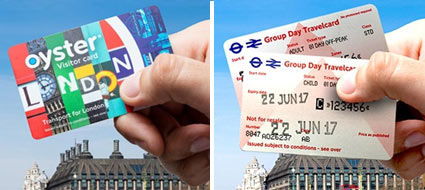
Visiting London? Save time and money on London public transport
• Visitor Oyster Card • Travelcard for 1 day anytime / off-peak or 7 days anytime • Group day travelcards available
LONDON TUBE MAPS (PDF)

This website uses cookies to improve your browsing experience and analyze the use of the website. Learn More
Reserve Your Spot with Confidence! Full Refunds with 24 Hrs Notice. Reschedule at any point, even after tour, if space allows!

How to Use the London Underground

Similar to the New York Subway or the Paris Metro, the London Underground is London's series of (largely) underground trains that run a regular service throughout the city.
Since the trains underground run through a series of tunnels, many people (Londoners and visitors alike!) refer to it as the "tube."
Despite this name, a lot of the London Underground network is above ground when you travel, particularly outside of central London.

The London Underground has 11 lines that serve Greater London, intersecting with each other in the centre of town.
The tube map is divided into nine zones, with Zone 1 being the centre of London, and Zone 9 being the suburbs.
The cost it takes to travel depends on which zone(s) you travel in, and how far your journey will take you.
It also connects to the London Overground (a suburban train line that doesn't run through the centre of town), the new Elizabeth Line (a high-frequency rail service that covers both central London, Heathrow Airport, and the suburbs), and National Rail Services (standard train lines that run throughout the country).
The Underground also connects to other rail services that serve the capital such as the Docklands Light Railway (an aboveground small train line that serves the docklands area).
WHEN DOES THE UNDERGROUND RUN?
In general, the Underground trains run from around 5:00 - 5:30 am until the last train leaves around Midnight, (exact times will vary and are listed on the Transport for London website ).
However, there are Night Tube services that run on some of the lines on Fridays and Saturdays for convenient travel on the weekends.
The Night Tube runs on parts of the Central, Jubilee, Northern, Piccadilly, and Victoria lines only.
- Tickets, Fares, and Oyster Cards
- The Tube Map
- Operating Hours
- Tips from Locals
- to/from Heathrow Airport
- Tourist Buses vs. the Tube
LONDON UNDERGROUND TICKETS AND OYSTER CARDS
Buying a ticket for the London Underground is pretty straightforward, but for most visitors, using a contactless payment card is the best payment method.
So, for a more in-depth explanation, including the cheapest ways to travel, check out our previous post about ticket prices and options here in London. Below is our summary.
There are 4 ways to pay for your rides on the Tube:
- Paper tickets
- Oyster Cards
- Contactless Credit/Debit Cards
We normally recommend avoiding paper tickets and recommend that you buy yourself an Oyster card, unless you have a contactless credit or debit card.
Rides with an Oyster Card or contactless card are much cheaper than paper tickets.
You can add as much money to these as you wish and there is a daily limit that you will spend, (£8.10 for Zones 1-2) so the rides get cheaper the more you use them. The same daily cap applies to your contactless card, too.
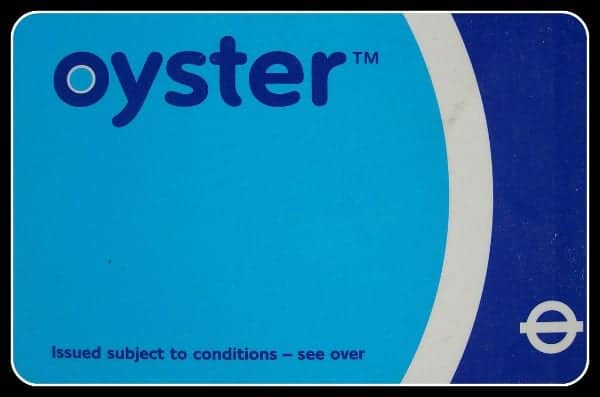
Read our post on which London Oyster Card or Travelcard to buy .
TIP: The Oyster Card is actually included with the London Turbo Pass at no extra cost. If you're planning to visit several notable attractions in the city, this could be a great way to save some money.
London Underground Fares
While there are 6 travel zones for the London Underground, most visitors to London will travel largely within Zones 1 + 2.
How much you pay depends on when you travel, whether during peak hours (06:30 - 09:30 and 16:00 - 19:00 Mon-Fri) vs. off-peak (all other times).
It also depends on where you travel to and from, and whether you are using a paper ticket vs. an Oyster, Travelcard, or contactless credit/debit card.
If you have one of the latter, then you will pay somewhere between £2.70 and £3.00 per ride within Zones 1 + 2.
The most expensive ride (Central London to Heathrow) will cost either £3.30 (off-peak) or £5.60 (peak).
Oyster and Travelcards can be used on all of London's public transportation options, including buses, DLR, the Overground, suburban trains (within London), a water taxi, and even a gondola.
Daily Limits
If you use an Oyster Card or a Contactless Card, then there are daily limits to what you will spend. These caps are dependent on where you are traveling within.
So, for example, if you stay within Zones 1 and 2, the cap for an adult is just £8.10 for the Underground and £5.25 for buses.
So, the more you ride, the cheaper each ride is. You can see what the cap is for each zone or between zones here.
Child Offers
Children under 11 travel for free and there is a 50% off on Oyster Card fares for children 11-15 years of age.
To receive this offer, you need to grab a Tube staff member at any Underground station, including Heathrow.
We help you determine which type of card or ticket you need in our in-depth post on Oyster Cards .
Travelcards
Travelcards are prepaid cards that give you unlimited access to specific zones within London.
You can choose to either order these in advance (in which case you will be given a paper Travelcard) or you can buy them upon arrival (in which case you will be using a plastic Oyster Card with the Travel Card loaded onto it).
Travelcards particularly have benefits for travellers here for an entire week. A 7-Day Travelcard can be worth your while, as a 7-Day Travelcard for Zones 1-2 is £40.70 which works out less per day than the £8.10 daily cap.
Find out more on our post comparing Oyster Cards, Visitor Oyster Cards and Travelcards .
UNDERSTANDING THE TUBE MAP
Picking up a Tube map is easy! They are available for free at most stations on the Underground network.
The maps on offer at the stations are small – perfect for carrying around in your pocket.
Below is a map of the London Underground. You could also download a PDF version .

Don’t be embarrassed to consult your map as you travel through London, even Londoners themselves occasionally need to check where it is they are heading to!
Some people will actually have an app on their phone sporting the London Underground tube map – though we think Google Maps App is very good.
If you look closely at the map, you will notice that the center part is shaded white (zone 1) with a ring of gray shade (zone 2) which is also surrounded by white again (zone 3).
Again, most visitors to London will spend much, if not all, of their time in Zones 1-2.
Focus on Colours
Every line on the London Underground has a different name and colour.
The names and colours will appear on your Tube Map, and also all over the various stations on the network.
For some, memorising the names is easier, but in general, colours can be the simplest way to learn your way around, and also to use when asking for/receiving directions.
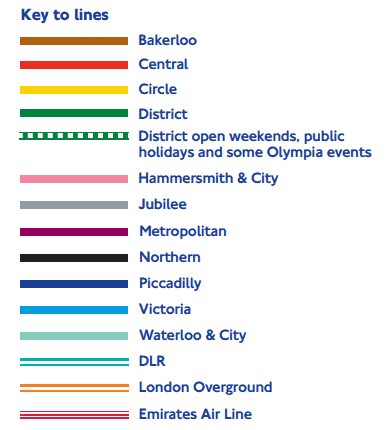
Generally speaking, any particular line will either head north-south or east-west.
FREE TOURS BY FOOT TIP:
Start your holiday in London with our All-in-One London Tour, which takes in most of London's legendary tourist sites and utilizes the London Underground. Get a tutorial directly from us.
OPERATING HOURS AND THE NIGHT TUBE
It’s important to remember that the London Underground system doesn’t run 24 hours a day every day and that timings may be different on weekdays vs. weekends.
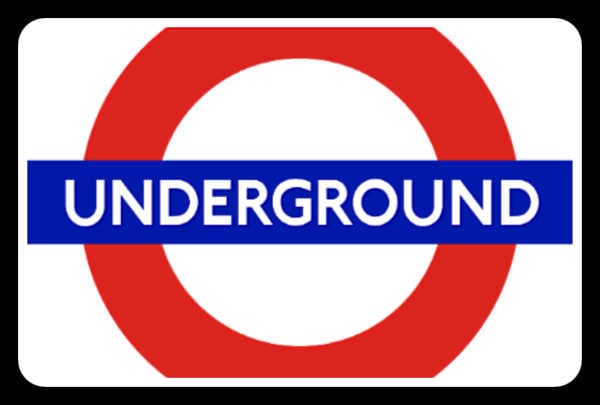
General Hours
Although each station has different timings, in general, the first tube trains start running around 5:00 am - 5:15 am and finish around 12:00 am - 12:30 am from Mondays through Fridays.
On Sundays, the Tube begins a bit later, around 6:00 am - 6:15 am and the final trains depart around 11:30 pm - 12:30 am.
Sundays also carry a reduced service which means there are not as many trains running as on Mondays to Saturdays.
Weekdays: 7:00 am - 9:30 am and 16:00 (4 pm) - 19:00 (7 pm).
Like any major city, London has a very busy rush hour in the mornings and in the evenings when the majority of people are travelling to and from work.
If possible, try to avoid travelling on the tube during these times, particularly if you have any large baggage/luggage with you.
Space is an absolute premium, which means you may have to wait as multiple trains pass you until there’s one with enough space to fit you in.
If you need a place to store luggage, read our advice here.
The Night Tube
As of 2019, some London Underground lines are now operating as The Night Tube, a 24-hour Underground service that operates on Fridays and Saturdays.
Really, this service should be called the "Overnight Tube" as the regular operating hours reach midnight every day of the week.
Click here for a downloadable pdf .

There are 5 lines making up the Night Tube and there are fewer trains operating, which means wait times are more than the standard 2 - 5 minutes.
The lines and approximate timings are:
- Victoria Line - Trains every 10 minutes
- Jubilee Line - Trains every 10 minutes
- Piccadilly Line (Cockfosters to Heathrow Terminal 5 ONLY) - Trains every 10 minutes
- Northern Line (Camden Town to Morden) - Trains every 8 minutes
- Northern Line (Camden Town to High Barnet) - Trains every 15 minutes (No Night Tube on the Bank and Mill Hill East Branches)
- Central Line (White City to Leytonstone) - Trains every 10 minutes
- Central Line (Leytonstone to Loughton/Hainault) - Trains every 20 minutes
- Central Line (Ealing Broadway to White City) - Trains every 20 minutes (No Night Tube on other branches of the line)
NOTE: The Night Tube operates with standard off-peak fare prices. Your daily travel card will be valid until 4:29 am the morning after you have purchased it.
TIPS ON NAVIGATING THE UNDERGROUND
Now we will provide you with our top 7 tips for navigating your way through the system, from how to enter a system, how to board the correct train, how to change lines, and when to walk instead of taking the Tube.
Underground Tutorial Tours
Let us, Free Tours by Foot , show you how to utilize the London Underground to get around the city - like our London in a Day or our Harry Potter Tour .

While these are not specifically Underground tours, your tour guide will assist you in learning how to master the system and to offer you some tips and tricks for riding the Tube.
1. Entering and Exiting Stations
All Underground stations have ticket barriers – large grey machines where travellers either insert their paper travel cards or tap their Oyster cards on top of them.
At first glance, most barriers all seem the same but they are actually divided into three different purposes; Enter, Do Not Enter, Bags/Buggies.

Some of the barriers will have a green arrow displayed – this means this is a barrier that you can travel through.
Insert your paper ticket, or tap your Oystercard on the yellow pad right next to the sign displaying the green arrow.
The barriers in front of you (just left from the arrow) will open and allow you to walk through.
Other barriers will have a red X displayed – this means this barrier will not open for you and is either closed or being used for visitors traveling in the opposite direction.
Lastly, some barriers are quite large, with signs displaying buggies, luggage, and wheelchairs.
These barriers are much larger than the regular grey ones and are there for people travelling with added items/persons.
They will not close as quickly as the others, giving travellers time to get themselves and all possessions through to the other side.
Read our post on taking the Tube from Heathrow Airport to Central London .
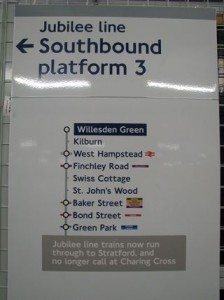
2. Find Your Correct Direction
In general, the Underground lines operate going north-south or east-west and vice versa.
Checking on your map will help you determine which direction you are travelling in, which will help you find the correct platform and train for your journey.
At every station, there will be maps like these showing the two directions that the trains will be travelling in, and under each direction will be a list of all the stations the train will stop at – in order!
This makes it easy not only to see which platform you need to be on but also how many stops it will take you to get to your destination.
3. Don't Board the Wrong Train
Sometimes, multiple Underground lines share the same track at a station. If you aren't paying attention, you could board the wrong train.
As the trains pull into the platform, you can take a glance at the front of the train. Here will be displayed the final destination of that particular train.
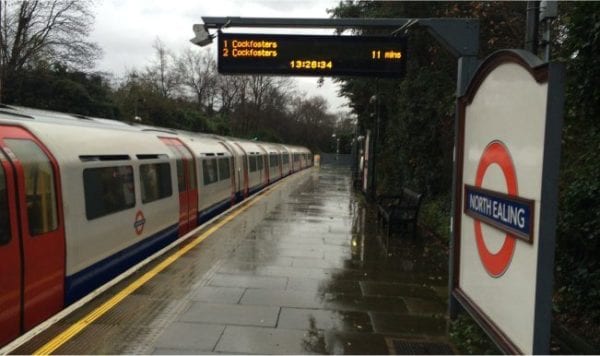
Also, on every platform there will be an electronic sign displaying the time until the next train arrives, and which station will be its’ final stop.
4. Lines that Split
Another potential mixup is lines that split. Some lines can have 2 or 3 different ending tracks, so you need to be aware of this.
Take the image below as an example.
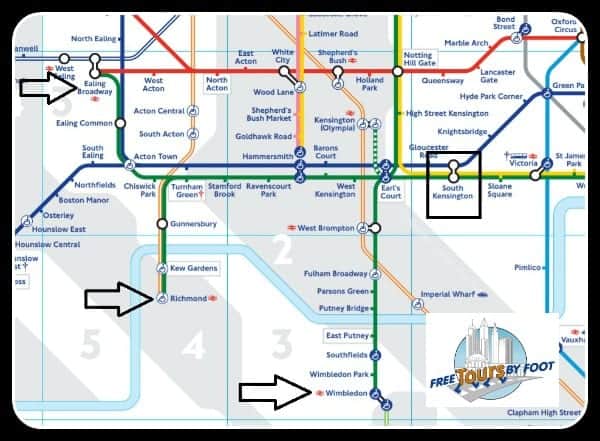
For example, suppose you plan on boarding a District Line (green) train at South Kensington Station (the black square) with a final destination Wimbledon (the bottom-most black arrow).
You would be taking a westbound train.
However, you can see from the map that there are two additional tracks with different ending points (Richmond and Ealing Broadway), all a part of the District Line heading westbound.
As you probably can tell, you could end up missing the first tennis match.
5. Changing Lines
The Tube map can often be misleading in that many tube lines crisscross over each other on the map, but do not actually connect to one another in reality.
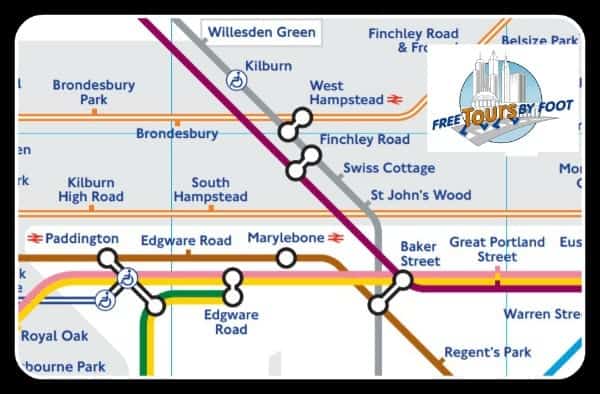
If you want to know where you can change from one Tube line to the other, you need to look for the white circle on the line on your map.
Any time you see one of these, it means you can change from one line to another or to British Rail.
Check out our tips on using the Underground with luggage and kids .
6. Sometimes You Should Just Walk
The London Underground Map is definitely NOT geographically accurate. Oftentimes it is easier to walk instead of getting on the tube to travel just a stop or two.
There is a map that gives the walking times between stations ( pdf ).
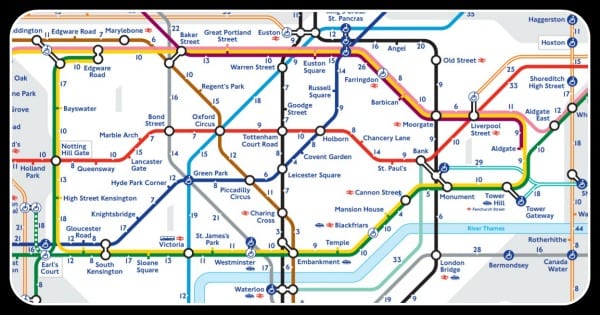
A good example of this is Leicester Square and Covent Garden on the Piccadilly Line.
On the map, they appear a fair distance apart, but in reality, it would take you just 4 minutes to walk the journey yourself.
Another good example is Charing Cross and Embankment - it’s just a 2-minute walk from each station!
7. Step-Free (Handicap) Access
For those with limited mobility, there are clues on the Underground map that will let you know if there is step-free access.
This is also useful if you are travelling with exceptionally heavy suitcases.
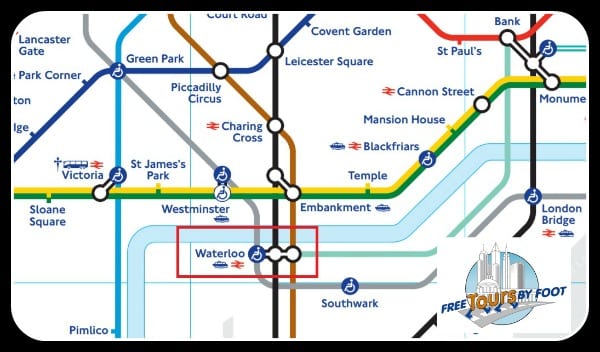
Simply look at the map, and on some stations, you will see a blue circle with a white figure in a wheelchair.
This means it is possible to get from the street into the train without any stairs or escalators.

The white circle and a blue figure in a wheelchair denote stations with step-free access from the street to the platform.
At these stations, you will need assistance to get into and out of the train, either with a ramp or the help of fellow passengers.
Note that in larger stations, such as Waterloo, the blue circle appears on one line only, which means the other two lines do not have step-free access. Transport for London has this helpful video .
A final note – Although London is generally a safe and welcoming city for visitors, pickpockets, and thieves operate throughout the entire London Underground network.
Please be aware of your surroundings, keep hold of all of your possessions, and avoid the habit of simply putting your ticket/credit cards/keys/mobile phones into your pockets – this will make you an incredibly easy target!
Also, never leave your belongings unattended on a train or in an Underground Station.
PICADILLY LINE TO AND FROM HEATHROW
By far the easiest and most affordable way to get to and from Heathrow Airport.
The Piccadilly Line runs through all 5 terminals of Heathrow Airport as well as straight through the centre of London, offering connections with every other tube line on the London Underground network.
Use our Google Map and input the address of your final destination for directions and travel time from Heathrow .
Travel time on the Tube is roughly 45 minutes to central London.
Piccadilly line trains run out of Heathrow from 5:00 to 23:00.
Ticket prices from Zone 1 to Heathrow are £6.70 for a cash-bought paper ticket, £5.60 on an Oyster card or contactless card at any time.
Read our full post on taking the Picadilly Line to and from Heathrow Airport .
TUBE ETIQUETTE
To avoid faux pas and keep from being marked out as a typical tourist, here are a few tips for Tube etiquette when travelling along the Tube.

1. Have Your Ticket Ready
Do not approach the ticket barriers until you have your Oystercard – or paper ticket – ready.
If you walk to the barrier and then fumble through your pockets/bags for your ticket, it will delay other travellers and oftentimes can mess with the barrier censors, potentially causing the barriers to lock.
[Remember you need a ticket both to BEGIN/ENTER and also to FINISH/LEAVE your journey!] Be sure to read our blog post on the Oystercard and Travel Card .
2. Stand on the Right
When riding escalators up and down in Underground Stations, please remember to stand on the RIGHT.
Travellers who wish to move up/down whilst on the escalators will be doing so on the left-hand side.
If you stand on the left you may find yourself politely asked to move to the right, or simply shoved past by a multitude of commuters.
This also includes your belongings/suitcases – they must be on the right of the escalators as well.
It is poor form and bad manners to take up the left side of the escalator with your belongings.
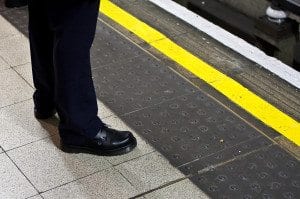
3. Stand Behind the Yellow Line
On every Tube platform, you will find a yellow line painted along the edge.
This line marks the boundary between where it is safe to stand, and where it is dangerous.
Stand BEHIND the line (not on top of!) in order to limit any risk of death or injury.
You may occasionally see passengers swiftly walking down the platform directly on top of the yellow line – but do not follow their lead!
4. Move Down the Platform
As soon as you get onto the platform, move either right or left.
You will find many people gathered at the entrance to the platform, meaning people cannot get past them and move onto the platform to get their train.
TIP : Besides just being courteous, the rear and front of the trains tend to be less crowded so moving down the platform means you’re more likely to get a seat!
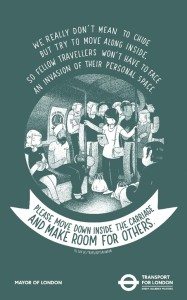
5. Let Other Passengers Off First
As soon as the Tube doors open, step to either side of the opening doors and let customers off the train before you attempt to board.
Failure to follow this rule may lead to verbal chastisement.
6. Move Down Inside the Carriage
Once you are inside the Tube – move away from the door! Standing in place will impede others who are trying to board.
Also (especially during peak times) it is important to move as far down into the carriage as possible in order for the maximum amount of people to fit onto the train.
You will see Londoners standing in between the benches on busy Tube carriages, and you should follow their lead.
7. Keep Feet and Bags Off the Seats
Particularly on crowded trains, it is unacceptable to take up an entire seat solely for your possessions – or your feet!
8. Do Not Lean on the Poles
The poles that are placed throughout the Underground train carriages are meant for people to hold on to.
Leaning against one of the poles means blocking the pole for those that may need it to hold balance whilst the train is moving.
9. Mind Your Earphones and Your Meals
The music you are listening to should not be loud enough for anybody else on the Tube to hear.
Also, it is best to avoid eating hot/smelly food on the Underground.
10. Get Out of the Way of Those Getting Off the Train
When you are on the Tube and at a stop that is not yours, make sure you are not in the way of those who are trying to exit the train.
Occasionally, you may need to step outside of the train to let passengers off if the carriage is very crowded.
This is expected behaviour, and you will be able to step right back on once the departing have left.

11. Stand Up for the Elderly and Pregnant
This is one even some Underground regulars need reminding of!
It’s just good manners in the UK to offer up your seat to the elderly, pregnant, or those who are less able to stand.
Be aware of who comes on the Tube at each stop and do not be afraid to offer your seat.
Occasionally you may see women with a small ‘Baby on Board’ badge with the London Underground logo pinned onto their coats.
Some men even take it upon themselves to stand up for any woman who comes onto the train so chivalry is not completely dead in London!
12. Take Your Rubbish Home With You
Rubbish left behind on the Tube is unsightly and can be quite disgusting.
There are no bins on Underground trains or at most Underground Stations which means it is expected that you will take any rubbish of yours off the train and home/back to your hotel with you when you leave.
On the London Underground, a little bit of courtesy and kindness can go a long way.
Commuting and travelling in the city can be quite stressful so try to remain courteous to others as you go about their business, and hopefully, they will do the same as you go about yours
HOP-ON-HOP-OFF BUS VS. LONDON UNDERGROUND
If you’re visiting London and aren’t sure about riding the London Underground, then we hope our tips above have made you more confident and willing to use the tube to get around town.
However, we understand that some people may still be a little anxious or unsure about the benefits of taking the tube, as opposed to riding one of London’s hop-on-hop-off tour buses.
To help you make up your mind, we’ve listed a few pros and cons of each below.

Hop-on-hop-off buses can be useful in getting an overview of the city or learning your way around town.
They are also quite useful for people who aren’t physically fit enough to walk through London day in and day out.
However, whenever possible, we strongly believe that the best - and the quickest - way to get around town is by taking the London Underground or to walk.
[Note that if you wish to take a hop-on-hop-off bus tour, we have a handy page HERE to help you choose which one to ride]
Pros of a Bus Tour
- easy to understand routes
- convenient stops at the most popular tourist attractions
- climate controlled all year (on the inside)
- tickets often include night tours, boat cruises, or free attractions.
- commentary along the routes
Cons of a Bus Tour
- more expensive than riding the subway
- routes are only one-direction
- wait times can be very long due to seasonal or even daily traffic
- buses can be crowded
- bad weather is always a risk
Pros of Riding the Underground
- (relatively) inexpensive
- flexible routing
- very warm in the winter
- you get to travel like a real Londoner
- Almost always faster than a bus
Cons of Riding the Underground
- not all stations are accessible for wheelchairs and strollers
- can be really hot and sweaty in summer
- can be really crowded during rush hours
- no commentary
Related Content
- Which Oystercard to Buy
- How to Get from Heathrow to London Centre by Underground
- How to Get from London to Paris by Train
- Things to do in London
- Most Haunted Places in London
Choose a Destination... I want them all PLUS general travel tips. Amsterdam Berlin Boston Charleston Chicago Dubai Lisbon London Los Angeles Miami Nashville New York City New Orleans Paris Philadelphia Prague Rome San Francisco Washington DC
About The Author

North America
United kingdom & ireland, middle east & india, asia & oceania.
Oyster Card Fares 2024 - London Bus, Tube & Daily Cap Prices
Oyster card charges for children, what is an oyster card.
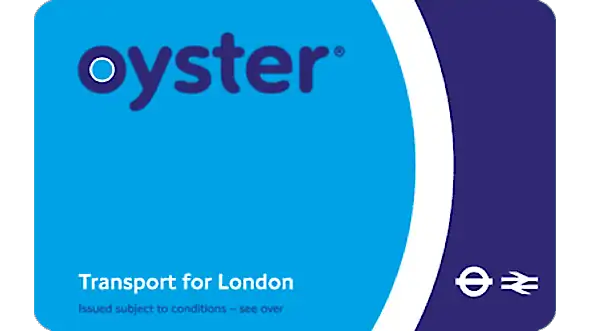
An Oyster card is a credit card-sized piece of plastic. Other countries might call them a metro pass or travel smartcard. They come in four different types:
Oyster pay-as-you-go – The idea behind a pay-as-you-go card (or PAYG) is that you load it up with credit and the computer will deduct the correct fare every time you touch it against a reader. If you start running low on credit then you can simply top it up at a ticket machine . PAYG Oyster cards do not have expiry dates on, and your credit remains valid forever.
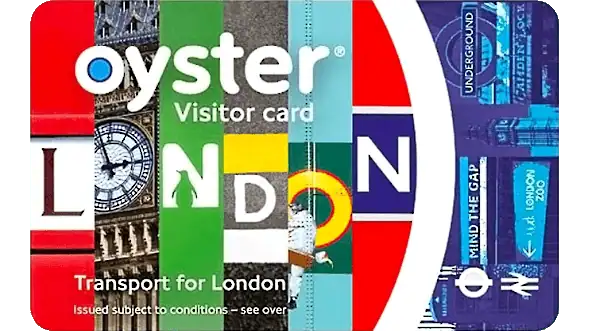
Visitor Oyster card – A Visitor Oyster Card is exactly the same as a normal pay-as-you-go card, but comes with a couple of extras that are primarily aimed at tourists. The most obvious difference is that it comes pre-loaded with credit to save you the hassle of having to load it on yourself. Check out our Visitor Oyster Card page for a full comparison of Visitor Oyster cards vs regular Oyster cards.
Oyster travelcard – Oyster travelcards work differently to pay-as-you-go cards because you don’t have to keep topping them up with credit. You simply choose your start date, and the zones you want it to cover, pay a one-off fee, and then you can make an unlimited number of journeys until it expires. Visit our London travelcard page for more details. [Note: it’s not possible to load a 1-day travelcard for the Train, Bus & Tram onto an Oyster card, and you can’t load any travelcards at all onto a Visitor Oyster card or contactless card , only the normal blue Oyster cards.]
Oyster travelcard + pay-as-you-go – It’s also possible to load some pay-as-you-credit straight onto an Oyster travelcard – but only the weekly and monthly ones.
This can actually be quite handy. Imagine that you’re travelling around zones 1-2 for a week, but you need to make a single journey into zone 6 for Heathrow airport . Buying a zone 1-6 weekly travelcard would be a waste of money just for a single trip, so you’re better off buying a travelcard for zones 1-2 and then loading on some extra pay-as-you-go credit on to cover it. The computer will recognise that your travelcard already covers zones 1-2 and deduct the difference from your credit.
What are the benefits of an Oyster card?
- Oyster is accepted all across the transport network: on the bus , London Underground , London Overground, DLR, TFL Rail, National Rail, Thames Clipper riverbus , and even the IFS Cloud Cable Car
- Oyster card prices for a single bus and tube journeys are always the lowest available (along with contactless), and the Oyster daily cap is always cheaper than buying a 1-day travelcard
- The Oyster daily cap means you can make an unlimited number of journeys without going above a set price
- Oyster pay-as-you-go credit can be used from zones 1 to 9, whereas travelcards are only valid in the zones you buy them for
- Oyster pay-as-you-go credit never expires, so if you have any left over at the end of your holiday you can use it on your next visit
- If you register your Oyster card and lose it then you haven’t lost all of your money – you can just put it onto a replacement card
What time is Peak and Off-Peak?
Peak – Peak fares apply to any tube journey that starts between 6:30 AM and 9.30 AM (Monday to Friday), and between 4.30 PM and 7 PM (Monday to Friday). It doesn’t matter what time your journey finishes.
Off-Peak – Weekends and public holidays are always classed as off-peak . Note: Between the 8th March and 31st May 2024 TFL are running a trial called ‘Off-Peak Friday Fares’, where Fridays will be classed as off-peak all day.
What is the Oyster daily cap?
Daily price cap – The big advantage in using a pay-as-you-go Oyster card over a TFL travelcard is the Oyster daily cap . Think of it as a price ceiling – it’s the maximum daily charge that the computer will take from your credit per day (it actually runs from 04:30 AM to 04.29 AM the following day). It doesn’t matter how many buses or trains you ride during that period, the max per day will never rise above the daily limit – and Oyster card cap rates are always lower than the cost of 1-day travelcard .
If you want to pay the bus cap (which is the cheapest one) then you’ll have to stick with the buses all day. If you use a mixture of buses and trains (or just the trains on their own) then you’ll have to pay the train cap instead.
Weekly price cap – Oyster users can also benefit from a weekly cap. This caps the price at the same rate as a weekly travelcard. Unfortunately it only runs from Monday to Sunday, and not any other combination of days, so if you’re here from Wednesday to Tuesday, for example, then you’ll just get 7x daily caps instead.
Note: Journeys to Gatwick airport and on the Heathrow Express don’t count towards the TFL daily cap, and journeys on the IFS Cloud Cable Car and Thames Clipper don’t count either. The computer will simply deduct the relevant charge from your credit.
What is the Young Visitor Discount?
If your child is aged between 11 and 15 then you can take advantage of the Young Visitor Discount to get cheap child fares . This allows kids to get 50% off the adult Oyster fare for fourteen consecutive days. The discount does not apply to travelcards.
All you have to do is buy your child a normal London Oyster card (not a travelcard), load some pay-as-you-go-credit onto it, and then ask a member of the TFL staff to apply the Young Visitor Discount to it. You can do this at London Underground stations, TFL Rail stations, National Rail stations within London, or at a London Visitor Centre (except the one at Gatwick airport).
Note: Your child must be with you when you do it (up to a maximum of four children per adult), and the member of staff may ask for proof of age.
Your child can then use the card in exactly the same way that they would normally, tapping it down on the yellow Oyster readers on the buses and trains.
Once the fourteen consecutive days are over any credit left on the Oyster card will still be there, but it will revert back to charging adult fares again.
Do seniors get cheap Oyster fares?
There are no senior citizen concessions for foreign visitors, but if you have an OAP bus pass with a red rose symbol on it then you can already travel for free on any bus carrying the TFL symbol:
Unfortunately it doesn’t apply to trains as well, just the buses. If you want to travel on the tube and live in a London borough then you’ll have to apply for a 60+ Oyster card :

60+ London Oyster photocard – This entitles you to travel for free on London’s buses , trams, London Underground , London Overground, DLR and TFL Rail after 9 AM on weekdays and any time during the weekend . Most National Rail trains within London can be boarded after 9.30 AM on weekdays and any time during the weekend.
In order to get one you have to be living in a London borough and be aged 60 or over. You can apply online at tfl.gov.uk by supplying some ID and proof of address.
Note: As soon as you’re old enough to receive a woman’s state pension (regardless of whether you’re a man or a woman) then you have to switch over to a Freedom Pass which offers similar benefits, but is supplied by your local council instead.
Can two people use one Oyster card?
Two people are not allowed to share one Oyster card if they’re travelling together. Each person will need to be in possession of their own card.
But if they’re travelling at totally different times then two people can share one card provided that they each have it in their sole possession for the entire journey. But this rule only applies to pay-as-you-go Oyster cards. If their Oyster card has a travel card loaded onto it then it cannot be lent to anybody else.
Can you pay two fares with one Oyster card?
No. It is not possible to pay two fares with one Oyster card. Lots of tourists tap them down twice making the perfectly reasonable assumption that it will subtract two fares, but the system doesn’t work like that. The first time you tap down the computer will think that you are entering the station, and the second time you tap down it will think that you are leaving the station.
At this point it all starts to get extremely confusing… if you tap down twice at the same station within 2 minutes then you will be charged for a ‘same station exit’, which is 1x maximum fare (from your station to the end of the line). This will automatically be refunded back onto your card if you begin a new tube journey within 45 minutes.
If you tap down twice at the same station within 2-30 minutes then you will be charged 1x minimum fare (from your station to the next one in the same fare zone). And if you tap down twice at the same station after 30 minutes then you will be charged 2x maximum fares (one for each tap).
Is Oyster the cheapest way to travel in London?
Oyster fares are the cheapest way to travel on London’s buses and trains (alongside contactless). But if you need to buy a brand-new Oyster card then you’ll also have to pay a £7 deposit on top – and you can’t get that money back. So contactless actually works out cheaper for first-timers.
The Oyster card cap is always cheaper than buying a day travelcard (but not if you have to pay the £7 deposit on top).
An Oyster card will also work out cheaper than buying a weekly travelcard, unless you’re planning on making three or more journeys on six days, or two or more journeys on seven days.
Where can you buy an Oyster card?
You can buy an Oyster card in four different ways:
From the TFL website – The easiest way is to buy an Oyster card online from the TFL website and have it delivered to you. This website is only suitable for people who live in the UK, though. If you want it delivered abroad then you will have to buy an Oyster card for visitors instead.
UK delivery typically takes between 2-4 days.
From a train station – The second way to get an Oyster smartcard is from a manned ticket window at a train station. TFL have removed all the manned ticket windows from the underground tube stations though, so if you want to speak to a human then you’ll have to visit a big National Rail station instead. (National Rail stations are the big overground hubs like Euston , Liverpool Street , London Bridge , King’s Cross , Marylebone , Paddington and Waterloo .)
From a Travel Information Centre – The third way is to buy one from a Visitor Centre at Euston station , King’s Cross station , Liverpool Street station , Paddington station , Piccadilly Circus station , Victoria station and Heathrow airport (there are actually two at Heathrow: one inside Terminals 2-3, and another one inside the Underground station).
From an Oyster Ticket Stop – You can also buy them from around 4,000 Oyster Ticket Stops all over London. These are basically just high-street shops (usually newsagents), which have a blue Oyster card symbol showing in the window.
Important – you have to pay a deposit of £7 the first time you buy an Oyster card, and you can’t use that money for fares. So if you decide that you want £20 credit then you will have pay a total of £20 + £7.
Where can you use Oyster in London?
Buses – You can use a London Oyster card on all TFL buses (but not sightseeing buses).
London Underground, London Overground, DLR, TFL Rail, National Rail – You can use Oyster cards on trains within Oyster zones 1-9, plus some stations outside the zones including Watford Junction (for Warner Bros Studios ) and Gatwick Airport.
Note: If you use it on the Gatwick and Heathrow Express then the fare won’t count towards the daily cap maximum charge. It will just deduct the fare from your credit.
Look at TFL’s handy map to see which stations are within the Oyster zones: http://content.tfl.gov.uk/london-rail-and-tube-services-map.pdf .
IFS Cloud Cable Car & Thames Clipper – You can pay for a ticket on the cable car and Uber’s Thames Clipper by touching your card down on the gate, in exactly the same way that you do for the buses and trains.
But bear in mind neither of these will count towards the travel cap, it will just deduct the relevant fare from your credit.
How do you top-up an Oyster card?
By using the TFL app – The simplest way to top-up an Oyster card is through TFL’s official Oyster and contactless app . Once you’ve bought yourself a card and registered it with TFL you can top it up with your debit card or credit card . You can also use the app to look up your journey history. [Note: You might have to wait for thirty minutes before the money actually appears on your card, which is something to bear that in mind if you’re in a rush!]
Through the TFL website – Similarly, once you’ve registered your Oyster card on the TFL website you can log in and top-up online.

At a train station – Another easy way to top-up is by using one of the self-service ticket machines at a train station. Just tap the card on the big round yellow reader and select top-up on the machine . You can either pay by cash, debit or credit card. Note that some ticket machines are only set up to take credit cards and debit cards, and not cash, so make sure you check the signage before you press any buttons.
At an Oyster Ticket Stop – The fourth of adding some credit to your card is at an ‘Oyster Ticket Stop’. These are basically just high-street shops (usually newsagents), which have a blue Oyster card symbol showing in the window. Just hand them your card and tell them how much credit you want to add on.
Automatic top-up – If you can’t be bothered to keep topping it up yourself then you can also take advantage of the Oyster card’s ‘auto top-up’ feature, which will automatically draw another £10, £20 or £40 from your bank account every time your credit drops below £20. You can set this up at the TFL website .
Note: The minimum amount of money that you can add at an Oyster Ticket Stop is £1.50. The minimum amount that you can add online or at a ticket machine is £5. The maximum amount that the card can hold in total is £90.
How much credit do you need on an Oyster card?
The amount of credit that you need on your Oyster card will depend on how long you’re staying in London for, and where you’re planning to go, but here are some tips for visitors:
Unless you fly in from Heathrow (zone 6) , you will probably spend the majority of your holiday inside zone 1 (the touristy bit). You might also visit zone 2 is for places like Camden , Canary Wharf and Greenwich.
Our tube journey planner will tell you which zones you pass through for each station. For example, if you look at the journey from Heathrow airport to Paddington then you’ll see ‘This journey is in zones 1-6’ written in the fares box.
Once you know which zones you’ll be travelling through each day, look up the ‘daily cap’ for those zones on this page. That is the maximum daily charge that the computer will take from your card for that day. If you add up all the daily caps for all the days that you’re staying in London, then the total will be how much credit you need to load onto your Oyster card. Easy!
Bear in mind that you will also have to pay a £7 deposit the first time you buy your Oyster card. And you can’t use that £7 towards fares. So if you decide that you need £20 credit then you will have to pay a total of £27.
How long does an Oyster card last?
The credit on an Oyster card lasts forever. If you don’t use the money up during your first trip then you can carry on using it during your next one.
If you load a travelcard onto an Oyster card then it will have an expiry date. Once you go past the expiry date the travelcard will be useless, but don’t throw away the empty Oyster card because you can always load another travelcard or some pay-as-you-go credit onto it.
How do you get an Oyster refund?
There are two main ways to refund the credit on your Oyster card :
At a train station – You can claim back any unused credit at a self-service ticket machine in one of London’s train stations – but only up up to a maximum of £10. Just touch your Oyster pass against the yellow reader and select ‘Oyster Refund’, and follow the on-screen instructions.
Note: It is not possible to claim back the deposit if your card was bought after 4th September 2022. If your card was bought between the 23rd February 2020 and 3rd September 2022 then you would have paid a deposit of £5 instead, and that money would already have been converted into pay-as-you-go credit on your card, which you can refund in the normal way.
Claiming a refund online – If you need a refund of more than £10 then you will have to visit the TFL website . But this only works if you set up an online account beforehand. And it’s not possible to set up an account for a Visitor Oyster card – only normal Oyster cards.
Keeping the credit – If you can’t be bothered to get a refund then don’t throw the Oyster card away. The credit never expires, so you can carry on using it the next time you’re in town.
How do you use Oyster on a bus?
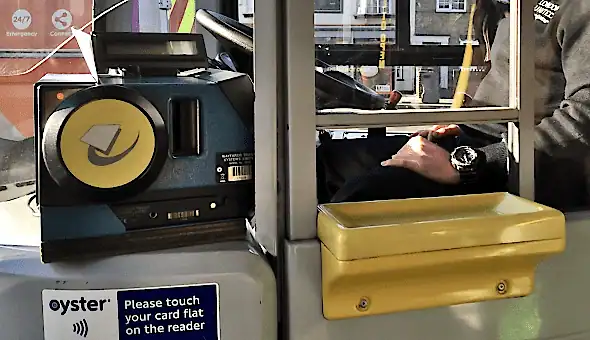
Using an Oyster card on a London bus is easy. All you have to do is touch it against the big round yellow reader inside the front door. Some styles of bus will also have an Oyster reader by the middle door and back door, but if you’re a newbie to London and want to play it safe then always board it by the front door, because every style of bus will have one there.
If the card registered correctly then you should hear a beep and see a little green light on the reader. If it didn’t work then try taking it out of your wallet and holding it flush with the reader.
The computer will automatically deduct the correct fare from your card, and the remaining credit will be shown on a small screen close to the reader – which is a handy way to check the balance on your card .
There is no need to touch down again when you leave the bus – you only have to do that for trains.
How do you use Oyster on a train?

Using an Oyster card on the train is easy. All you have to do is wave your Oyster card in front of the big round yellow reader at the front of the gate, and wait for the green light to appear. If it worked correctly then the correct fare will be deducted from your card and the gate will open automatically.
If the gate refuses to move then try getting your card out of your wallet and touching it flush against the reader. If that doesn’t work then you’re probably out of credit.
Some of the smaller train stations might not have any gates, and you’ll find the Oyster reader on the platform or by the platform stairs instead.
You also need to touch down again at the end of your journey because the computer needs to work out which zones you travelled through. If you forget to touch down then it won’t know where you went, and you’ll be whacked for the maximum fare on that line.
Note: Sometimes the train station staff will open the gates to speed the flow of people through the station at rush hour, but you must STILL tap down. If there’s a busy event on (like a music festival or a football cup final) then you might not be able to, and the computer might try and guess your destination by itself. But you should always try and tap down to be safe, otherwise you might be lumbered with that maximum fare.
What are pink Oyster readers for?
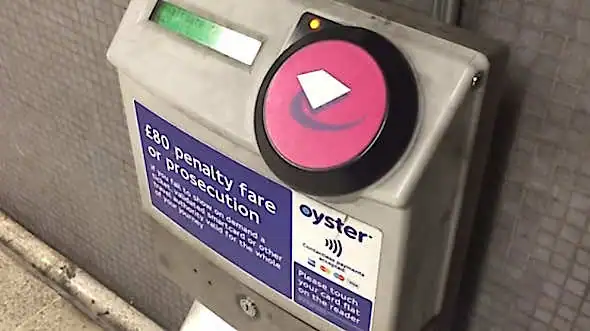
Fifteen stations have pink Oyster readers: Blackhorse Road , Canada Water , Clapham Junction , Gospel Oak , Gunnersbury , Highbury & Islington , Kensington Olympia , Rayners Lane , Richmond , Stratford , Surrey Quays , West Brompton , Whitechapel , Willesden Junction and Wimbledon .
The pink readers are there because some journeys are cheaper if you avoid travelling through zone 1. For example, if you want to travel from Epping (zone 6) to Richmond (zone 4), then you would normally go through zone 1. But if you don’t mind a slightly longer journey then you can change onto the London Overground at Stratford and bypass zone 1 completely.
Unfortunately the computer has no way of knowing you did this because you don’t have to pass through any barriers when changing trains at Stratford – so it will continue to charge you for zones 1-6 regardless. So what you have to do is prove that you got off at Stratford by touching down on the pink reader.
Pink readers can usually be found on the platforms, or at the entrance to the platform stairs.
Which is best: Oyster, contactless or travelcards?
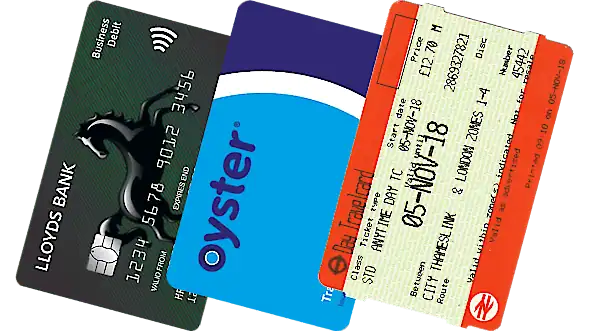
If you’re a foreign visitor coming to London for just one day then you’re better off with a day travelcard . The Oyster daily cap might work out cheaper than buying a 1-day travelcard, but when you factor in the extra £7 deposit then it actually works out more expensive.
If you’re a foreign visitor coming to London for more than one day then the Oyster card cost becomes better value… unless you’re planning on making three or more journeys on six days, or two or more journeys on seven days, in which case a weekly travelcard is likely to be cheaper.
We always recommend that UK visitors pay with contactless , regardless of how many days they’re staying. That’s because the fares are exactly the same as Oyster, but you don’t have to pay a deposit to get one.
Note: If you’re a foreign visitor then Oyster is still preferable over contactless, because your bank might add on a transaction fee every time you use it overseas, which will likely apply to each individual ticket.
The verdict: Contactless is the best option for UK visitors. Oyster is the best option for foreign tourists staying more than one day, and a 1-day travelcard is the best option for foreign tourists staying for just one day.
Your comments and questions
Isabel I am visiting London next month. This will be my first visit and I need some advice about the best way to get train tickets outside London, for instance, to Winchester and Cambridge. If I get an Oyster card, can I use it for national railway service?
Staff You can use an Oyster card for National Rail trains, but only for zones 1-6 and some of the stations in zones 7-9. Winchester and Cambridge are both too far away, so you'll need to buy a separate ticket from a site like nationalrail.co.uk
Kim Hi, I am planning a trip for my husband's 50th birthday. We are arriving at London Euston. We are staying at the Doubletree Hilton Tower Bridge. I want to pre-purchase my Oyster travelcard, but am confused as to what zones we will need to cover? Any help and advice would be most welcome! Regards Kim
Staff Hi Kim. Euston and Tower Bridge are both in zone 1, but if you're planning to put a travelcard onto your Oyster card then you can't buy zone 1 on its own. You can only buy zones 1-2. But that's okay because that will cover you out to Greenwich as well. But the easiest thing to do is to not bother with a travelcard at all, and just load some credit onto your Oyster card. Then you can use it as a 'pay-as-you-go' card. The computer will deduct the correct fare whatever zone you're in.
Wendy I'm a newbie to using an Oyster card on the tube and am only an occasional visitor to London, so I have just topped up my PAYG card which I purchased a couple of years ago. Cool, eh? I am planning a visit tomorrow and my friend and I are travelling from Richmond to Wimbledon. I have checked the route planner and it tells me that I have to get the District line to Earl's Court, then change trains but get on the District line again to Wimbledon. My question concerning the Oyster card is this: having tapped the yellow 'thingy' to begin my journey, then passed the card to my friend to allow him entry, when we exit the train and get on the other train to Wimbledon, do we have to tap anything and if so, what and where? I am just conscious that I may be charged more than the off-peak fare, which it should be running for this journey. Thanks for your help, Wendy
Staff Hi Wendy, that isn't going to work unfortunately. You each need your own pass. If you try and share one Oyster card between the two of you then you could be done for fare evasion. I suppose it is common sense to think that if you tap the same card down twice then it will charge you twice, but it doesn't work like that. Only one fare will be registered. But you don't have to tap down again when changing trains at Earl's Court. You should be able to walk between the platforms without going through any barriers. You only have to tap down again once you leave the station at Wimbledon.
Faye How far around London can you travel on an Oyster card? eg: can you go from Finsbury Park to Oxford/ Brighton/ Stratford Upon Avon with a Visitors Oyster card?
Staff Hi Faye. Oyster only works for zones 1-6, plus most of the stations in zones 7-9 (but not all of them), so you definitely can't go as far as Brighton or Oxford. Here is a map which shows you all the stations covered by an Oyster card: tfl.gov.uk/cdn/static/cms/images/london-rail-and-tube-services-map.gif
John My wife and I are in London next weekend from Friday to Sunday arriving in to Euston and staying near Pimlico station. Is it a good idea to pre order an Oyster travelcard? We plan to do the usual sightseeing in Central London.
Staff Hi John. If you've got enough time beforehand then it makes sense to order one online, but it will be less hassle if each of you just use your contactless bank cards instead (assuming you both have UK bank cards). It's the same price as Oyster, works in exactly the same way, and you don't have to pay the £7 deposit.
Patrick Hi there. I am new to this site. Please advise on the following scenario. Before I leave Australia, if I buy the 2 or 3 day London Pass with Oyster Travelcard option, can I begin using the Oyster card for a few days before I activate the London Pass? I assume the travel credit will be used up before the London Pass begins, at which point I would re-charge the Oyster to cover the days of the London Pass. Can I then continue to use the Oyster card for the following 2 weeks that we will be in London?
Staff Hi Patrick. You can do that, sure - the London Pass and Oyster card are two completely separate cards. The Oyster card will come with some money pre-loaded onto it. The exact amount will depend on which London Pass you buy, but it should be enough to cover the daily cap for each day. You can keep using it until the money runs out, and then you can top it up again at a self-service ticket machine.
Jools Hi there, first time I will have bought an oyster card, can one card be used for a family of four
Staff Hi Jools, no. If you're travelling together then you will each need your own Oyster card or ticket. If you touch the same card on the gate four times then it won't charge you four fares. The computer will just think that one person is entering the station, then leaving the station, then entering again, then leaving again
Park Is there an admin charge to set up an Oyster card? I'm on route to London now and am presuming I can buy one at a station. I'll be using my contactless bank card myself but need one for my adult daughter
Staff Hi Park. You have to pay a £7 deposit for Oyster cards. She can't use that money to pay fares, though, so you'll have to add some more credit on top.
Kory I have two Oyster card on my account with different numbers can my friend use one of these at the same time I am using the other one, as we will be travelling together.
Staff Hi Kory. As long as it's a pay-as-you-go Oyster card then that's fine. But if it's an Oyster card with a travelcard on it, or you get some kind of discounted travel on it, then that wouldn't be allowed.
G Thomas If I pay the £7 deposit to buy an Oyster card how long will it last? ie. will I be able to use it next time I visit London or will it have time-expired?
Staff Hi G Thomas. If you put some pay-as-you-go credit on an Oyster card then that last forever, so you will be able to use that the next time you come. But if you put a travelcard on an Oyster card then that will obviously expire on the finish date. But you can still carry on using the Oyster card by putting a new travelcard on it, or some pay-as-you-go credit.
Debbie My husband and I will be visiting London tomorrow. Can we buy an Oyster card valid for a year and say put £15 credit on each, and am I to believe the total amount for that day travelling would be £7.20 off our cards then the balance can be used on another day within that year. We will travel from Victoria, to Oxford Circus to Knightsbridge and Kensington and back. What is the total lay out we would need to pay for each card? Kind regards Debbie
Staff Hi Debbie. Oyster cards don't have dates on. The unused credit on them lasts forever. The maximum you would pay for the stations you mentioned is the daily cap for zone 1 = currently £7.20. The prices normally go up after New Year, so I don't know what it will be next year. But remember that you have to pay a £7 deposit for each new card, and you can't use that money for fares, so if you want to load £15 credit on to each card then you'd have to pay 2x£22.
john Sweeney Where can purchase i an oyster card for adults before travelling to london on holidayand how much will it cost
Staff Hi John. If you're in the UK then you can buy them from the TFL website and have it delivered to your house - oyster.tfl.gov.uk/oyster/link/0005.do - if you're abroad then you'll have to buy a Visitor Oyster Card instead (which is basically the same thing) - visitorshop.tfl.gov.uk/tfl/london-visitor-oyster-card - It's all explained in the 'Buy an Oyster Card' section above. The cost is up to you - you can load as much credit on as you want, depending on how much you need for your holiday
Jupin kheni I have a regular travel from Edgware to Tottenham. So, which zone travel card applied for me?
Staff Hi Jupin. if you’re talking about Tottenham Hale station then the stations themselves are in zones 3 and 5, but if you look at a tube map the journey between them goes into zones 1 and 2 as well. So you’ll need zones 1-5
Jim Can a child travel free with an adult using a contactless card or does it need to be an Oyster? Thanks.
Staff Hi Jim. They have to be with a fare paying adult on the train, so a contactless card is fine (assuming that they are under 11, of course). On the bus they can travel on their own.
Melanie Hi, I need to take underground (leichester square to kings cross) then overground (kings cross to Kidbrooke) the a bus. I am trying to understand how much will be charged in my oysters card. I have also linked the Railcard 16-15 for discounts. Thank you
Staff Hi Melanie. It will be zone 1 and zones 1-3 (not including the bus, which you might also be able to pay on your Oyster card, depending on what bus it is) your railcard will get you 1/3 off the zones 1-3 fare if you're travelling during off-peak hours
Gerard If you use contactless instead of oyster do you still benefit from the price cap?
Staff Hi Gerard. You do, yes - londondrum.com/transport/contactless-cards.php
Lorraine We are visiting London for 3 days sun until Tues 4 adults 2 children age 9 and 11arriving at Paddington staying near tower is it worth getting oyster cards if so can we buy at Paddington station when we arrive
Staff Hi Lorraine, assuming you're from the UK the adults are better off just using their contactless bank cards because they have the same fares as Oyster, but you don't have to pay the extra £7 deposit on top for each new Oyster card. Oyster cards can be picked up from the Travel Information Centre at Paddington station. The 9 year old will travel for free, and if it was me I would just get the 11 year old three 1-day travelcards, but you could get them an Oyster card and have the 'Young Visitor Discount' applied to it. It's all explained here - londondrum.com/transport/child-train-fares.php
Antonio We are staying near Penge East Station and the quickest way to get to Central London is with the Southeastern to Victoria. Is that train included in the Oyster or Contactless daily cap?
Staff Hi Antonio. Yes, Penge East in zone 4, so you’ll be paying the price for zones 1-4
Narendra Patel No wounder with the prices as they are there are more cars on the road. Only people who use TFL are the ones who work in London. For a couple we are looking at £28+ which unless you are born with a silver spoon is very expensive. I can see TFL continue to make losses. More TFL prices are hiked more losses.
David I have a question about daily caps. The tables appear to provide charges and caps as if the trips are all in one category. However, what if I use the Oyster card three times for trips from Zone 1 to 2 during a single day and have just exceeded the daily cap of £7.70. Then I travel from Zone 1 to Zone 6 on the same day. Am I charged for that trip? Does the cap change? And if so, to what?
Staff Hi David. The system looks at all the zones you travelled through that day together. So in your example the maximum you’d pay is the daily cap for zones 1-6. If the total for all your individual journeys doesn't reach that cap then you'd pay for the individual journeys instead. if you only want to pay the daily cap for zones 1-2 then you’d have to use a completely different card for the zone 1-6 journey (maybe you have a contactless card)
Robert Schultz My plans are to visit London. I will arrive at Heathrow on Friday May 27th and depart London Monday May 30th. I have a Hop on Hop Off Big bus tour pass to see some of the major attractions. Im trying to figure out which Oyster Card I need to move around London to see other places. I will be out of the city on Sunday so I need a rail card that will move me around London for Friday, Saturday and then to the train station on Monday morning. I dont really understand the different zones. Do you have any suggestions on what card I need and where to buy it when I arrive at Heathrow Airport friday morning?
Staff Hi Robert. I would just get an Oyster card from the Visitor Information Centre at Heathrow. you have to pay a £7 deposit and then add as much credit as you want. you’ll need to cover the fare for zones 1-6 from heathrow into central london, and then enough to cover the ‘daily cap’ each day (which is the maximum amount you'll be charged each day). most people just need the daily cap for zone 1, which covers the central touristy bit of london. but if you’re planning on travelling around on that sightseeing bus one day, then maybe you can use that instead
John I am a retired Network rail worker with a privilage travel card,i wish to travel from Euston sq. to Aldgate on 03/07 and from Aldgate East to Wimbledon and back to Aldgate East on 04/07,on 05/07 from Aldgate to Euston sq. Can you tell me if I can purchase a reduced Oyster card for these travels in advance?
Staff Hi John. You really need to ask your old employer as we don't have any information about Network Rail staff discounts. There's an email address listed here that might help you: networkrail.co.uk/mybenefits/
Ondrej Hi, I have 3 Oyster Cards registered on the TFL Website. Can I use 1 for myself, 1 for my wife and 1 for a child with a discount (11-15 years)? Regard Ondrej
Staff Hi Ondrej. Normally if an Oyster card only has pay-as-you-go credit on it, then yes, it's fine. But if you've loaded a travelcard or any kind of discount on to it, then no... if it's registered under your name then only you will be able to use it. If a non-registered person is found with a card registered in someone else's name then technically TFL can confiscate it and even fine them.
Sam Hi can you use the oyster card at East of India train station
Staff Hi Sam, yes. You can use it at all of the DLR stations
Susie I will be arriving next week for the marathon and will be staying in the Bloomsbury area for 5 days. I have loaded an Oyster card with £20. I can use this visitor Oyster card any time of the day?. Not sure what zones I will be in. Do I need to load more oney to cover my stay?
Staff Hi Susie, you can use it any time of day, but £20 probably won’t be enough to cover 5 days… but it all depends on how many journeys you make. the maximum amount its possible to spend each day, regardless of how many journeys you make, is the ‘daily cap’ for the zones you travel through (shown in the table above). the minimum amount you'll spend is probably a zone 1 single fare there and back each day, which still adds up to more than 20 quid over 5 days. and bear in mind that there will be a train strike going on which might affect people getting to the london marathon
Raul We are traveling to London next month, two adults and two children (13 and 15) from tuesday to saturday. We will take train from Feltham to Victoria Station (zones 6 to 1) and back at the end of the day. Will the daily cap be 14.10 pounds? Can I take later other transport such as the metro, bus, during the day (zones 1, 2, 3) and the limit is still 14.10? Thank in advance!
Staff Hi Raul. Thats right. You can make as many journeys as you like and the maximum price you’ll get charged is £14,10 (assuming that all of your journeys are within zones 1-6, of course)
RAUL Thanks you for your answer. Then I can mix several public transports (tube, bus, train) and the daily cup will be 14.10 if I move between zones 1 to 6
Staff Thats right, yes
PEDRO We will be traveling to London next month for 3 days and we are going to get 2 Oyster cards for the adults and other 2 with Young visitor discount for our children (13 and 14). From what I have read they will pay the half of adult fare but, what is their daily cap for them? is it the same that for the adults? Many Thanks!
Staff Hi Pedro. Everything is half what the adult fare is. The adult daily caps are listed in the table at the top
PEDRO Thanks so, is the daily limit cap 7.05 pounds for them?
PEDRO Sorry, I mean zones 1 to 6
Staff Thats right yes
Russell I will be travelling to London for 4 days, arriving through Heathrow, and staying in St Pauls area. I will be travelling with 24 fifteen year old children. What is the best way to pay for our travel whilst in London (visiting the usual tourist sites).
Staff Hi Russell. I would look at the Group Day Travelcards, that would probably be the easiest. but bear in mind they only last for one day each, can only be used after 9:30 AM (or at any time during the weekend), and you all have to travel together - visitorshop.tfl.gov.uk/en/group-day-london-travelcard
Carol How do I get Senior discount on Oyster card if I have a Senior railcard
Staff Hi Carol. You just have to ask a member of the TFL staff inside a station (you can usually find one standing by the ticket barrier). If you have both the Oyster card and Railcard handy (or the digital card on your phone) then they can add it on - tfl.gov.uk/fares/free-and-discounted-travel/national-railcard-discount (they mention it at the bottom of the page)
W Shes How can I check the remaining time I have on a 7 day oyster?
Staff Hi. You can tap it down on a self-service ticket machine at the station and follow the on-screen instructions
Susanne Hi! We will be in London in June and stay 7 days. We will do 3 journeys between Heathrow zone 6 and Victoria zone 1 and move a lot inside zone 1 and 2. If I buy an Oyster card for 7 £I understand I can pay as I go in zones 1 to 6 with a daily cap of about 9.50 £. Now as we will travel every day, would it be cheaper to put a Travelcard for 7 days zones 1-2 on the Oyster card and use the pay as you go for the Heathrow trips to zone 6? (Knowing that on 2 of the 7 days we will only do 2x Heathrow .) Or can we use the travel card for zones 1-2 to Heathrow as well with a supplement?
Staff Hi Susanne. A weekly travelcard usually works out cheaper if you're doing two or more journeys on each of the seven days, or three or more on six of the days. But like you say, it would definitely be better to put a zone 1-2 travelcard onto an oyster card, and then add some extra pay-as-you-go credit onto the same oyster card to cover the remainder of those journeys into zone 6. (PS the daily cap for zones 1-6 is a bit higher - £14,90 at the moment)
P Ray Harrington I arrive LHR April 13 and go to Greenwich and west ferry. April 14 Greenwich to green part and back to Greenwich. April 16 Greenwich to amersham, April 22 amweaham to green park and return. All of peak. What cars and credit should I apply please?
Staff Hi. I would get yourself an oyster card and add enough credit to cover the ‘daily cap’ each day. heathrow to greenwich and westferry is zones 1-6. Greenwich to green park is zones 1-2. Greenwich to amersham is zones 2-9. Amersham to green park is zones 1-9. The prices are all shown in the table above.
Fran Rae I am visiting London this Saturday with grandsons aged 14 and 17 and will be using the tube. I can pay pay by contactless but how do I pay for them? Thanks FR
Staff Hi Fran. If it's just a day trip then you're best off buying single tickets at the machine, or an adult 1-day travelcard at the machine for them. It's not worth getting them Oyster cards because you have to pay a deposit which will wipe out the savings. And you can't buy child travelcards unless they already have their own Oyster photocard
Theo Lemm What is the minimum credit to use the National Rail from London to Swanley?
Staff Hi Theo. its zone 1-8, so the minimum is £4.70 (off-peak)
Theo Lemm Ok. But Swanley has no gates. So what happens if I check in with less than 4.70 credit?
Staff When suburban stations don't have gates, they usually put the yellow oyster card reader at the foot of the stairs, or on the platform itself. Is there not one there?
Theo Lemm Swanley is the final destination.
Staff There must be a yellow oyster reader somewhere, otherwise they wouldn't be able to take oyster and contactless fares. it's not unusual for there to be no gates at suburban stations. check the platform, the stairs and by the exit
Manuel Brito from Portugal Excellent article, very informative, thank you!
You must enable javascript to leave a comment

Myki Q+A: Straight answers to your questions
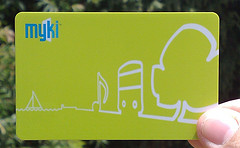
Updated January 2024
Now that almost all public transport users in Victoria have to use the trouble-plagued Myki ticketing system, people need simple answers to basic questions about it. This page is an effort to explain how the Myki system works, and answer the main questions we are asked.
Where can I get a Myki?
Cards can be obtained online or by phone ( 1800 800 007 6am – midnight daily). You can also get them from Myki Card Vending Machines (which are located at railway stations, some tram platform stops, and some major bus interchanges), from staff at Premium (staffed) stations , or from PTV Hubs at Southern Cross station and 750 Collins Street, Docklands, and in Geelong and Bendigo.
Mykis can also be purchased at many metropolitan retail outlets and some country retail outlets, particularly, but not exclusively, 7-Eleven stores, as well as some Australia Post outlets in major regional centres. See here to get the location details of retailers selling Myki.
Cards can also be bought from most bus drivers in metropolitan Melbourne (except pre-pay-only services such as the 401 and 601 university shuttles), and from bus drivers on the regional city bus networks which use Myki.
Note that only full-fare Mykis can be purchased from Myki vending machines. Concession, child and seniors Mykis must be bought from the other outlets listed above.
How much does getting a Myki card cost?
The cost of a card is $6 full fare, or $3 concession. The purchase price is not refundable. People who become eligible for a free Seniors Myki should apply for one as part of their application for a Seniors Card .
Note that Myki Card Vending Machines only dispense full-fare cards. Concession, child and Seniors cards can be obtained from staffed railway stations, retail outlets, at a PTV Hub , or online. More information on where to get a Myki card .
Where can I add money to my Myki?
You can top up your Myki at all the places listed in the previous section, except for the regional Australia Post shops selling Myki, which only provide cards pre-loaded with some credit.
Mykis can also be topped up by bus drivers (minimum amount $1.00, maximum amount $20).
Why can’t I get a short-term ticket?
With no short-term alternative, anyone wanting to use public transport in Melbourne must have a reusable Myki card with sufficient credit loaded on it, even if they only travel every now and again.
That ridiculous decision means that the PTUA receives complaints about the difficulty occasional travellers have in trying to get or use a ticket.
Even regular public transport users can strike problems. If they forget to have their Myki with them they have to buy another one and put money on it. If their Myki becomes defective, unless they can get to a staffed railway station or PTV Hub, people have to wait for up to ten business days for a new Myki to be issued to them. In the meantime, if they want to travel they have to buy another card and put money on it.
The convenience of short-term tickets is obvious. Before their abolition on major regional city bus networks in mid-April 2013, up to sixty percent of passengers were using them.
How does Myki Money work?
Note: Fares increased by about 5% on 1 January 2024.
You buy a re-usable Myki card and load credit onto it. As you travel you touch on and touch off, and the system will debit your Myki card as you go. Melbourne metropolitan fares are shown in the following table. Regional fares differ from this. For full details of fares see the relevant page of the PTV web site .
Concession fares are 50% of the above prices. Discounts (e.g. Earlybird free travel on trains before 7 a.m.* and Weekend Cap $6.30) apply to Myki Money.
Note that the 2-hour period is exactly that and is timed from the moment you touch on. However, if you touch on after 6 p.m., the 2-hour fare applies until 3 a.m. the next day.
A “daily cap” applies: if you make multiple trips in one day, the system charges you a maximum of two 2-hour segments, e.g. the Daily fare.
If your travel is eligible for the Weekend Saver daily fare (Saturdays, Sundays and public holidays), then Myki charges you a maximum of $6.30 per day ($3.15 concession). If you’re a Senior, the normal daily cap is $4.30, but on weekends, Seniors receive free travel for trips entirely within one or two consecutive zones (including within Zones 1 and 2), and on regional town bus services. Note that even though they are not charged under those circumstances, Seniors are still required to touch on and off.
*Under Earlybird there is actually a 15-minute grace period to allow for late trains, so Myki gives you free travel on trains if you touch on and touch off by 7:15 a.m.
How does Myki Pass work?
Note: Fares increased by about 5% on 1 January 2024.
Myki Pass is what used to be called a periodical ticket. You buy the normal Myki card and then choose to add credit to turn it into a periodical “pass” for your chosen period — for 7 days, or anything from 28 to 365 days — for the zone or zones you want. Note that these are consecutive days, and are not related to calendar months.
So the price for a “monthly” Pass is based on a particular number of days, not on a calendar month (where the number of days varies).
Current Melbourne metropolitan fares are shown in the following table. Because travel across Zones 1 and 2 costs the same as a Zone 1 fare, Zone 1 passes are not available. Passengers need to purchase a Zone 1 + 2 pass, which costs no extra. Regional fares differ from this. For full details of fares see the relevant page of the PTV web site .
Concession fares are 50% of the above prices. Although only the 30 and 325+ day prices are listed above, you can buy a Pass for anything from 28 to 365 days. For full pricing details see the PTV web site , or the Victorian Fares and Ticketing Manual .
*Note that you can get a discounted Yearly Pass via the PTUA Commuter Club , which provides a more than 9% reduction on the retail price of a 365-day Myki Pass shown above. Commuter Club Mykis are specially-coded Myki cards which are provided free with the discounted Yearly fare.
Can I combine Myki Pass and Myki Money?
Yes. A single Myki card can have a Myki Pass for travel in your usual zone or zones, and also have Myki Money loaded on it for occasional trips into other zones, including V/Line services.
How does Myki work on V/Line?
Myki operates on V/Line’s so-called “commuter” services but the government has decided that Myki will not be used on what are now called “long-distance” railway services – those running beyond Geelong (Waurn Ponds), Ballarat (Wendouree), Bendigo (Eaglehawk or Epsom), Seymour and Traralgon – nor will Myki be used on any V/Line bus services. Those services continue to use paper tickets only.
The Family Traveller concession still requires a paper ticket, regardless of your destination. Available on most V/Line services, the Family Traveller allows one adult to be accompanied free by up to two children (aged 16 years and under) during off-peak times. At all other times, one child can travel free and one child needs to have a valid ticket. See here for more detailed terms and conditions.
V/Line passengers using Myki who travel in more than two zones (and that is the case for most V/Line journeys) must have:
- a Myki Pass for their entire journey and a Myki Money balance of at least $0.00; or
- a sufficient Myki Money on their card to pay for their entire journey; or
- a Myki Pass for part of their journey and sufficient Myki Money to pay for any remaining part of the journey.
V/Line Myki Pass users may travel to a destination beyond the Myki ticket area by purchasing a paper ticket extending their journey. However Myki Money users cannot use such a “hybrid” ticket. If their journey partly includes a service not covered by Myki, a paper ticket to cover their entire journey must be purchased prior to departure.
Under Myki, the concession which allows single (one-way) ticket holders one hour’s free travel in Zones 1 & 2 either side of their V/Line journey, and free Zone 1 & 2 travel all day for all other ticket types, including day return, continues to apply . Myki users must still touch on and off where required, but the Myki system will not charge anything over and above the fare already deducted. However passengers are urged to keep a close eye on their card balance to make sure the system always operates as required.
This same concession also applies to travel on the regional town bus systems on which Myki operates.
Passengers taking long journeys on V/Line commuter services are given additional time to complete their journey without incurring any extra fare. Note: Some increases in this allowance were made on 1 January 2016
- Travel across 3- 5 Zones : 2½ hours allowed
- Travel across 6-8 Zones: 3 hours allowed
- Travel across 9-11 Zones: 3½ hours allowed
- Travel across 12-13 Zones: 4 hours allowed
So a passenger who touches on in Zone 8 at 9.30 a.m. and touches off in Zone 1 at 11.15 a.m. (an 8-zone trip) pays a Zone 1-8 fare which expires at 12.30 p.m.
If touch-on occurs after 6.00 p.m. the fare does not expire until 3.00 a.m. the following day.
The discount fare for off-peak travel, which provides a 30% reduction over the normal fare, is available under Myki for all services timetabled to arrive in, and depart from, Melbourne outside the designated peak times.
To obtain the off-peak concession, V/Line passengers using Myki should not touch on at a station in the morning before the off-peak period commences. In the evening a 15-minute “grace period” applies. Although the off-peak period starts at 18:00 (6 p.m.), a passenger using a V/Line train can touch on after 17:45 (5:45 p.m.) and still obtain the off-peak fare.
For full pricing details see the relevant table in the Victorian Fares and Ticketing Manual .
Does the PTUA provide discounted Yearly tickets under the Commuter Club scheme?
Yes. PTUA members who are regular public transport users can buy discounted Yearly tickets, at about 9% off the retail price, and that includes a free Myki card. You can see full details of the offer here . Commuter Club is also available via some employers.
Note that Commuter Club is only a Melbourne metropolitan program. Even though Myki is used on V/Line commuter services, Public Transport Victoria says there is no plan to extend Commuter Club availability beyond the metropolitan area.
However, passengers travelling to Melbourne from Zone 2 stations which are only served by V/Line trains, such as Tarneit, Wyndham Vale or Melton, are eligible for Commuter Club.
Other V/Line passengers can purchase a 365-day Myki Pass at a heavily discounted rate, which includes up to 40 days free travel.
Can I get a refund if I no longer need the Myki Pass I purchased?
You can apply for a refund of a partly-used Myki Pass or an unused Myki Pass, as well as unused Myki Money. You can either do that by filling out an online application , or by completing the paper Myki Refund & Reimbursement Form . However refunds are not available on expired Passes, and you cannot get a refund of the purchase price of a Myki ($6 or $3 concession) .
Note that if you use the paper from you must return your Myki card with it. In that case, you will need to have another Myki card in order to travel, because of the government’s stupid decision not to include the planned short-term ticket in the Myki system.
The refunded amount can either be sent to you as a cheque or the unused funds can be transferred to another Myki. You can also convert Myki Pass credit to Myki Money, although an amount over $250 can only be paid by cheque.
It takes up to 10 business days for a Myki Pass to be converted to Myki Money and up to 21 business days for cheque refunds to be processed.
Can Myki be used to track my movements?
You can choose to register your Myki, or not, as you wish.
It is possible to get a card completely anonymously from Myki vending machines or over the counter. Unregistered cards get access to the same fares.
If you register your card you are protected against theft or the loss of the card, because you can report the loss, have your Myki deactivated, and have the remaining credit balance transferred to a new card. You can also set a registered card to be topped up automatically with money from your bank account.
Public Transport Victoria (PTV) has published a privacy policy which goes into some detail about when they might provide someone’s travel data to authorities. You can read it here .
Can someone else use my Myki?
It is perfectly legal for other people to use your Myki, provided that it only has Myki Money loaded on it. However you are not allowed to share your card if Myki Pass is loaded on it.
Does the credit on my card expire if I haven’t used it for 90 days?
No it does not. This idea is widespread but completely false.
However, if you top up your card using the Myki web site, and do not “collect” that money onto your card (e.g. touch your card on a reader, or check the balance at a vending machine) within 90 days, the system “archives” the top-up amount (and only the top-up amount), meaning that you cannot add that money immediately to the balance on your card.
Your archived top-up will be re-activated, and sent out again to readers and vending machines, when you use your card on the system again (for example, touch it at a reader, or use it at a vending machine), and you will then be able to “collect” the archived amount onto the card.
Note however, that this reactivation process can take up to 24 hours, so if your balance is too low to allow you to travel, you will need to top up your card immediately (for instance at a vending machine) if you want to use it there and then.
Can I travel if my Myki has a negative or debit balance?
Only in certain circumstances. Your Myki must have a balance of at least $0.00 (i.e. not negative) for you to be able to touch on, but you can go into negative balance during the journey if you are only travelling in one or two zones, which is the case in metropolitan Melbourne and on regional city bus systems.
However, most V/Line journeys will take you through more than two zones, and if that is the case, you must have sufficient credit on your Myki to cover the whole journey (see “How does Myki work on V/Line?” above).
Note that if you break the journey during which your Myki goes into negative balance, any other touch on will be refused, even if the two-hour travel period has not expired.
It is also important to note that even though the Myki Pass on your card may be valid for travel, you cannot commence a journey using Myki Pass if the Myki Money balance on that card is negative. For your Myki Pass to be valid, your Myki Money balance must be at least $0.00.
How do I touch on and touch off?
Touch on your Myki ticket at a reader as you enter the station, or as you board the tram or bus. Touch off the ticket at a reader as you leave the station, or leave the tram or bus.
You must place the ticket flat on the reader. Don’t “swipe” it, or move it around, because the reader will take longer to respond or not read the card at all.
The card must be within about half a centimetre of the reader, but preferably touching it. It will usually work from inside a wallet or bag, especially if the Myki ticket is in the closest pocket, but this isn’t guaranteed. It will often not work if you have other cards in your wallet which use similar technology (an RFID chip), because that confuses the reader.
One of the major problems with the system is that the response times of Myki card readers are inconsistent and often too slow, particularly in buses — sometimes readers respond in under a second, but too often they take a good deal longer. Although new Myki barriers with faster response times have been installed at some stations, it is ridiculous that the problem is still with us ten years after Myki was first introduced.
Do I really need to touch on every time?
You need to touch on every time you enter a station, tram or bus to ensure your ticket is valid for travel, even if you have already touched on somewhere else for the particular journey you are undertaking.
In reality, you must touch on the first time you use a ticket for a particular journey, to set its expiry date and time. Not doing so is fare evasion.
There is an exception to that, however. You don’t have to touch on or off if you travel on a tram entirely within the “Free Tram Zone” which covers Melbourne’s CBD and Docklands. There is a map of the Free Tram Zone here .
But if your journey starts or finishes outside the boundaries of the Free Tram Zone, you must touch on your Myki in the normal way to make sure you have a valid ticket.
You must touch on when boarding a bus, even if your ticket is already valid for that journey, so that the bus driver knows you have a valid ticket. You must also touch on when boarding at railway stations if your destination is a gated station, otherwise the gates at your destination may not let you out, and you may have to queue for staff assistance.
You should also touch on and touch off if you are travelling on a Myki Pass outside the zone(s) you have paid for.
Do I really need to touch off every time?
Except on trams (see below), the official line is yes. If you don’t touch-off, you may get charged a default fare, which may be more than you’d otherwise pay.
The default fare is charged when the system doesn’t know where you got off the train/tram/bus, and it assumes you might have gone to the end of the line (on a tram/bus) or to the last stop of the longest line on the system (metropolitan trains).
In other words if you don’t touch-off on buses and trains the Myki system may assume you took a two-zone trip, and charge you for it. If this is the correct fare anyway (for instance you’ve travelled on a train from the CBD to a Zone 2 station) then you will not be charged anything extra if you do not touch-off, and so you can choose not to do so.
As noted above, you still need to touch on and off if you are travelling on a tram entirely within the Zone 1/2 overlap, if you want to ensure that you pay the cheaper Zone 2 fare.
The default fare does not apply to Myki Pass if you touched on (started your journey) in your nominated zone. In other words, if you have a weekly/monthly/yearly Pass on your Myki card, there is no need to touch off when travelling in the zone(s) covered by the Pass.
The government says it gets useful statistics about travel patterns if people touch on and touch off every time. However, they supposedly got useful statistics with the old Metcard system, as well as through manual surveys, but that hasn’t stopped services getting very crowded due to a lack of forward planning and investment over the past few years.
Why don’t I have to touch off on trams?
There was an obvious likelihood of congestion on trams resulting from the number of passengers trying to touch on and off at busy stops. Therefore, all tram routes were modified to be within Zone 1 (areas formerly in Zone 2 only are now all within the Zone 1/2 overlap), and so you do not have to touch off on a tram if you are only travelling within Zone 1, because the default fare on trams is a Zone 1 fare only.
However if you travel on a tram entirely within in the Zone 1/2 overlap, which only occurs right at the end of routes 75, 86 and 109, you do need to touch off before you alight to ensure that you are only charged the cheaper Zone 2 fare.
Do I get charged for another 2-hours if I touch off after the expiry time?
No. Your Myki ticket is valid as long as you touch on at a station, or board the tram or bus, before the expiry time.
I heard weekly/monthly/yearly Passes aren’t valid on weekends.
That is not true. They are valid on weekends, but only in the zones you’ve paid for.
A single-zone weekly/monthly/yearly Metcard used to be valid in both Melbourne zones on Saturdays and Sundays. That benefit has been withdrawn under Myki. The government argues that is necessary in order to be consistent with regional areas, and yet no regional area has the $6.30 weekend daily fare cap which is available in Melbourne.
The result is that Myki Pass users must pay extra if they travel into another zone. But their total fare will attract the $6.30 weekend/public holiday cap, and what has already been paid towards that is taken into account.
Why does the information displayed on the reader vanish too quickly for me to read it?
The information showing your card balance, and the amount deducted for your journey, will be displayed for as long as you hold your card to the reader, so hold it up for longer if you want to check that information. However, some of the new card readers on railway station barriers do not display any information about the status of the card.
You can also use a Myki Card Vending Machine or a Myki Check (blue-colured) machine to find out the status of your card.
I’ve heard that a Myki card has an expiry date.
The validity of a Myki card expires four years after purchase, although the expiry date is not shown on the card itself. Note that the expiry date is set when the card is first loaded with credit, so if you buy a pre-loaded card that has been lying around for a while before you bought it, the expiry date may be a lot less than four years away.
You can find out when your card expires by checking it on a Myki Card Vending Machine or blue Myki Check machine. These are situated at railway stations, some tram platform stops, and some major bus interchanges. You can also find out a card’s expiry date by ringing 1800 800 007 and quoting the card number.
If you have registered your Myki you can find out the expiry date by logging on to your account via the PTV website . People who have registered their Myki will be reminded of the imminent expiry by PTV before the expiry date.
When your Myki expires you can go to any staffed railway station or PTV Hub to get a free replacement card. The remaining balance on your old card will be transferred to the new one. If your Myki has a negative balance, you will have to top-up to a positive balance as part of the replacement process.
If your expired Myki is registered, the replacement card will also be automatically registered. However, if you have auto top up linked to your expired Myki, you will have arrange auto top up again for your new card.
Does Myki Money always give me the best fare?
Provided everything works correctly, it does give you the best daily fare, by charging you the cheapest possible fare for each trip, and upgrading it automatically, for instance from a 2-hour Zone 1, to a Daily Zone 1+2 — whatever is cheapest for your day’s travel.
But if you use it every day, the system does not automatically upgrade you to a cheaper 7-day Pass or a 30-day Pass etc. Myki Pass must be pre-loaded to attract the cheaper periodical fare.
I heard you have to pay extra if the train is late.
No, not on trains, but you may be affected if you want to make use of the 2-hour fare and you catch trams and buses .
Under Myki, your ticket is valid as long as you start your trip (that is, touch on at the station, or as you board the tram or bus) before the 2-hour travel time expires.
This is only a problem when using trams and buses, because you only touch on as you board. When using trains you can enter the platform and touch on before the expiry time, no matter how late the train you are catching might be.
If you are going to travel for more than 2 hours it makes no difference to you, but if you are trying to make a couple of short trips using a bus or tram in a single 2-hour period, with no other travel that day, you will be charged the daily fare if the bus or tram arrives late, after your 2-hours has expired.
What’s the use of compensation being paid as Myki Money, when I have a Myki Pass?
Monetary compensation for poor service delivery can only be claimed if you have travelled for 10 or more days with a Myki Pass that is for 28 days or longer.
When Yarra Trams , Metro Trains or V/Line miss their monthly performance targets, you can claim compensation. Given the electronic nature of the Myki system, it is ridiculous that getting compensation is a manual process, involving filling in a form and posting it. It seems obvious that the system is designed to discourage passengers from getting the compensation they are owed.
Compensation is paid as the Myki Money equivalent of the zones covered by the Pass, rather than extending the duration of the Pass.
There are several ways to make use of the Myki Money compensation:
- Use it after your Pass expires. Note, however, that if you have another Pass loaded on your card, the Myki system will always use that first if it is valid for your trip.
- Use it for travel in other zones, including V/Line journeys.
- Request that the compensation amount is added to a different Myki card, such as a family member’s card, or a second card that you use. This option is on the form.
- Pay for your next Myki Pass using Myki Money. This is done by putting enough Myki Money on your card to pay for the Pass, then choosing the option on vending machine to buy a Pass with Myki Money. Unfortunately this option appears to only be available from vending machines.
Is Myki switching us to distance-based fares?
No. The current zone system is being retained.
Hong Kong and Singapore and some other cities use fares based on how many kilometres you travel. Myki does not include this change and fares remain almost identical to those under Metcard, based on the zones (which will now spread across Victoria) and duration (2-hour, daily, etc.) of travel.
The PTUA believes that distance-based charging has some disadvantages − it may lead to higher fares, and it is quite confusing, because you might not know how much you’ll be charged before you travel.
How do ticket inspectors and V/Line conductors check tickets?
There is little information printed on the Myki card itself, and no obvious way of telling whether you have validated correctly or not. Authorised Officers (ticket inspectors) and V/Line conductors use hand-held devices that can read the cards.
Has Myki slowed things down?
Yes, in some situations.
Station exits during the evening peak have become congested as train-loads of people queue to touch off. The unacceptably slow and inconsistent response times of card readers do not help in this regard. To ease the problem, more readers have been added at stations, new or widened station exits have been provided, and new barriers with faster card readers have been installed at some stations.
Buses should have benefited from faster boarding times but Myki readers on buses are notorious for their slow and inconsistent response times.
The government’s decision not to allow single-use tickets to be purchased might have speeded-up bus operations (although quite a few bus passengers top-up frequently with small amounts as an alternative), but that is at the expense of occasional users who do not have a Myki, or passengers who have forgotten to have their Myki with them.
Touching off has been made optional on trams, to avoid delays (see above). Whether delays occur depends to a great extent on how quickly the readers respond, and how many there are. It is worth noting that London’s buses and trams were both switched to a flat fare system, requiring no touch-off, because delays during disembarking were causing problems.
Does Myki work properly?
Virtually every aspect of Myki’s introduction has been poorly handled. The PTUA has flagged a number of design and implementation problems with Myki that need fixing , and we are continuing to give feedback to Public Transport Victoria.
The biggest drawback with the Myki system is the state government’s unexplained decision not to make single-use tickets available, meaning that every public transport user must have a Myki card, loaded with sufficient credit, to be able to travel. This makes things extremely difficult for tourists, for new and occasional public transport users, or for passengers who have problems with their Myki, and it will be a further source of fare evasion.
As noted above, the other major and persistent problem with the operation of Myki is that response times of card readers are inconsistent and often too slow − sometimes they respond in under a second, but very often they take a good deal longer. That is unacceptable, and it has been allowed to continue for far too long.
As soon as Myki began operating, the PTUA asked that different sounds be introduced for a touch on and a touch off. Instead of that, we got the totally unnecessary introduction of a double beep for concession passengers.
Opportunities for buying and topping up cards are still too limited, especially for tram and bus users.
There have been a number of instances of people mistakenly “touching on” at blue Myki Check machines, rather than the proper Myki card readers, and then being fined for not having touched on. We have asked PTV to make changes to the relevant hardware and software which will make this less likely to occur.
Watch the system very carefully to ensure you’re being charged correctly. Keep a close eye on the Myki readers as you use them, check your transactions on the Myki Check machines (the blue machines in stations and some trams stops) at vending machines and/or via the PTV web site, and ring 1800 800 007 or contact PTV online if you suspect you have been overcharged.
Was it worth the money?
Probably not. Although the Myki system brings some benefits , including better access to cheap fares, these are eclipsed by the enormous cost of the system.
Few passengers wanted a new ticket system, and the PTUA argued that for a fraction of the cost, either the previous Metcard system could have been updated, or a cheaper Smartcard system bought from elsewhere. The money saved could have been spent on more staff, trains, trams and buses. But the change has happened, so we’re providing feedback to Public Transport Victoria to try and improve the outcome for passengers.
Further questions?
Email office at ptua.org.au with your questions. We’ll endeavour to find out the answers and post them back here.
If you want to read all the fine print yourself, it’s contained in the Victorian Fares and Ticketing Manual . Be warned, the Manual is over 100 pages long.
Public Transport Victoria has posted some useful information on its web site, which you can read here .
You can ring PTV for information, on 1800 800 007 (6 a.m. – midnight daily).
You can also go to a PTV Hub to get assistance. There is one near the Collins Street entrance of Southern Cross Station (pictured). There is another Hub on the ground floor of the PTV headquarters building at 750 Collins Street, Docklands, about 500 metres from Southern Cross station. That Hub can perform more operations than the one at Southern Cross. For example the Collins Street Hub includes the Pass Office, which issues the various forms of free travel passes which are available on the public transport network. There are also PTV Hubs in Geelong and Bendigo.
What is the PTUA anyway?
Founded in 1976, the Public Transport Users Association is the recognised consumer organisation representing passengers of all forms of public transport.
We are a non-profit, voluntary organisation, with no political affiliations. If you want to help support our work, please join us . You get five newsletters per year, as well as access to cheap Yearly tickets , and you’ll be helping the campaign for better public transport in Melbourne and around Victoria.
Pricing and Fare Zones
The price of your trip depends on when, where, and how you are travelling.

On this page
Save time and skip the lines! Tap your bank card or mobile wallet at the faregate to pay for your ride.
Fare Increases
Fares are increasing on July 1, 2024 . Please see the July 1 fare pricing table for full details.
There are three fare zones across Metro Vancouver. The number of SeaBus and/or SkyTrain boundaries you cross during your trip determine your fare.
All bus and HandyDART trips are a 1-Zone fare at all times.
SkyTrain requires a 1, 2, or 3-Zone fare, depending on the time and day* and number of zone boundaries you cross during your trip.
SeaBus requires a 1 or 2-Zone fare, depending on the time and day*
*All journeys across the system starting after 6:30 p.m. weekdays and all travel on weekends (Saturday, Sunday, and holidays) are a 1-Zone fare.
A single fare is valid for 90 minutes on bus, SkyTrain, SeaBus, and HandyDART.
YVR Airport AddFare
Please note: Journeys after 6:30 p.m. that start at YVR Airport, Sea Island Centre, and Templeton Canada Line stations will still incur a $5 YVR AddFare charge. For more information about this charge and who is exempt, please see our Transferring and AddFare page.
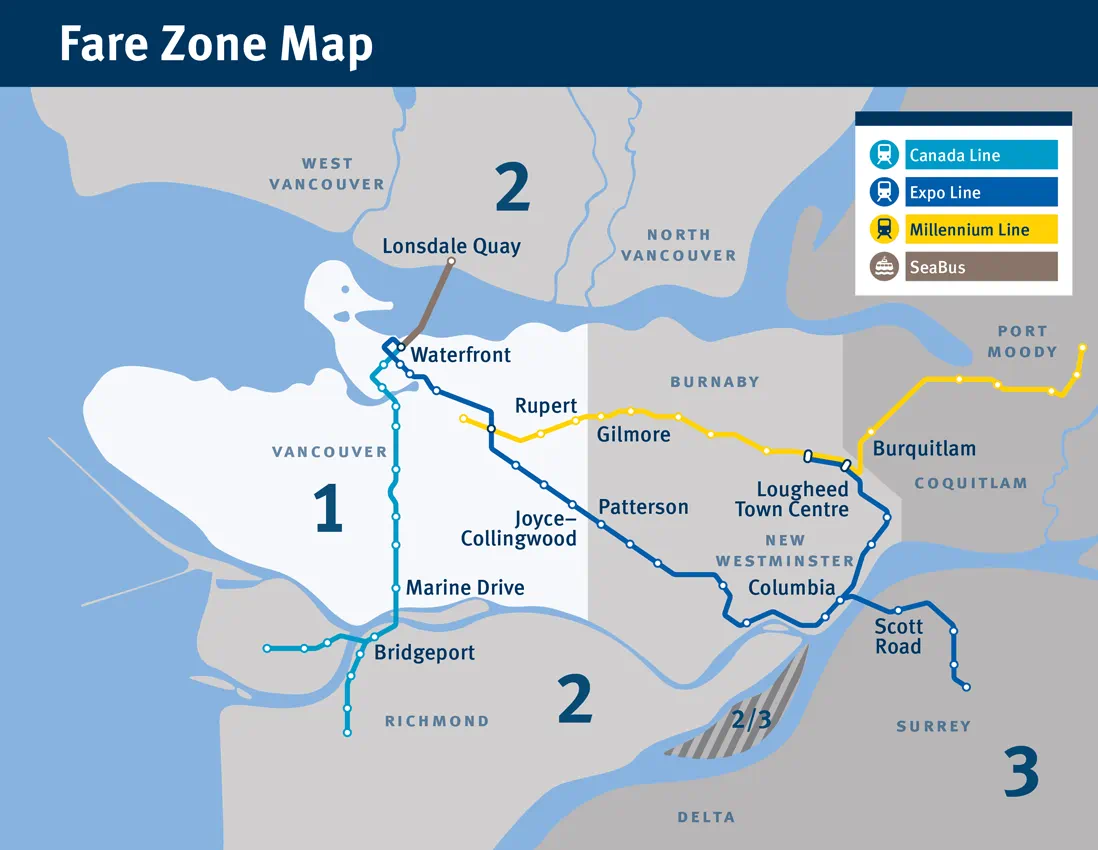
Fare Prices and Concessions
Concession fare eligibility.
Passengers who are eligible to our discounted concession fares include:
HandyCard holders
seniors 65 and older*
youth 13 to 18 years*
children 5 to 12 years
Children 12 and under ride free when accompanied by a fare paying passenger possessing proof of payment. A maximum of four children can travel free per paying passenger. (Fare-paying passenger not required for bus travel)
*Must present valid photo ID proving age
Current Fares (In-effect until July 1, 2024)
For West Coast Express (WCE) Fares, please visit the WCE Fares page .
For HandyDART fares, please visit the HandyDART page .
For Transfers and AddFare , including the YVR AddFare, please visit the Transferring and AddFare page .
Future Fares (In-effect July 1, 2024)
Compass card.
Find out how to pay for transit on our Compass Card page.
Estimate your Fare
Buses are a 1-Zone fare, all day, every day. Cash fares on buses are not transferable to SkyTrain, West Coast Express, or SeaBus.
Plus an additional $5 YVR Airport AddFare if starting from YVR Airport, Sea Island Centre, or Templeton Stations.
Paying Your Fare
Paying on the bus and handydart.
Using a Compass Card, Compass Ticket, contactless payment cards, or mobile wallet.
When you board, tap your card, ticket, or mobile wallet on the card reader located near the bus doors. You don't need to tap out when exiting.
Place the coins or bills into the fare box (no change can be given). You'll be handed a bus transfer from the Operator that is your proof of payment and can be used to transfer between buses (but not on SkyTrain, SeaBus, or West Coast Express).
For more information about paying on HandyDART, visit the HandyDART page.
Paying on SkyTrain, SeaBus, and West Coast Express
When you travel on SkyTrain, SeaBus, or West Coast Express, tap your card, ticket, or mobile wallet to the card reader at the fare gates (or validator for West Coast Express) as you enter and exit a station to validate your fare. Tapping reserves the fare for a 3-Zone trip, or a full-distance trip in the case of West Coast Express.
When you tap out, the system calculates the fare zones you've travelled and charges you the correct fare. This applies to all products, including Monthly Passes.
Paper bus transfers are only valid for transfer between buses.
Proof of Payment
Transit vehicles and all areas within fare gates are Fare Paid Zones.
All customers must pay the fare required by the TransLink Transit Tariff and carry proof of payment whenever they’re aboard a transit vehicle, within fare gates, or within any station area that is designated as a Fare Paid Zone.
Valid proof of payment:
Compass Cards and Compass Tickets with a valid fare that has been successfully tapped in are accepted as proof of payment on all modes.
Validated FareSavers (no longer sold) and bus transfers are accepted as proof of payment on buses.
Transit Police and Transit Security regularly conduct fare checks. Ensure you’ve tapped your Compass Card or Compass Ticket to validate your fare, and have them, along with any required valid identification, available for inspection, if asked. On buses, keep your bus transfer for inspection.
Anyone who fails to produce proof of payment with valid identification on request will be asked to leave the vehicle and risks facing a fare infraction ticket with a fine of $173.
Visit our Fare Infraction page for more information on paying or disputing a fare evasion ticket.
Paying as a Group
For large group trips (e.g., school field trips), you can bulk purchase Compass Tickets ahead of time. Visit our Group Travel page for all the details.
Contactless Payment
Taking transit and don’t have a Compass Card? No need to print a ticket. Save time, skip lines, and go straight to the gate!
Our card readers accept contactless Interac Debit, American Express, Mastercard, and Visa credit cards along with Apple Pay, Google Pay, and Samsung Pay. Go paper-free and help the environment. All you need to do is tap your card or device on the fare gate or bus card reader to pay.
Like a Compass Card, you can only use one payment device per person. You still have 90 minutes to make your transfer across bus, SeaBus and SkyTrain services (120 minutes on West Coast Express services). Be sure to tap your card, not your wallet, and to use the same card when transferring between buses, SkyTrain, SeaBus, and West Coast Express to avoid getting multiple charges. Final charges are determined by when you tap out at the end of your trip. Single adult cash fare applies. For discounted fare, use a Compass Card.
Watch Out for Card Clash
If you tap your wallet or phone case, multiple credit cards may be charged. Remove your credit or debit card from your wallet or phone case before you tap.
Keep in mind that Tap to Pay is unrelated to your Compass Card. Currently, there is no Compass App.
Avoiding Charge for Uncompleted Trips
If you tap in and decide not to complete a trip, you can easily reverse your charges. If you tapped on a bus, please ask the driver to reverse the tap for you. If travelling on rail, you can undo your initial tap in by tapping out of the same station within 21 minutes on SkyTrain and SeaBus, and 60 minutes for West Coast Express.
Transit Police Security Checks
Transit Police and Transit Security use FIA (Fare Inspection App) to check fares. If you've paid using Tap to Pay, police or security personnel may use an handheld device to detect if your credit card, debit card, or mobile device is an accepted form of payment and has been tapped into the system.
Kids 12 and Under Ride Free
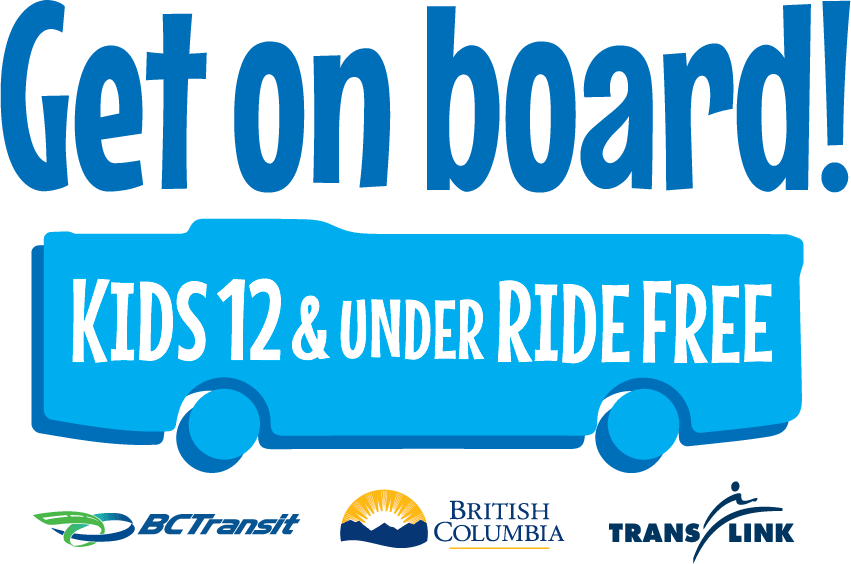
As of Sept. 1, 2021, children 12 and under can ride TransLink services free of charge as part of a new provincial program. This change makes it easier and more affordable for families in and around Metro Vancouver.
Learn more about Transit Tips for Kids .
Note to Parents and Guardians
While travel for children 12 and under is free, parents and guardians are responsible for educating and making decisions about the safety and care of their children whenever travelling on transit. This includes when children are travelling unaccompanied and determining if their children can or should take transit unaccompanied.
Children 12 and under can ride buses free of charge without requiring a transit pass, identification or an accompanying fare paying customer.
SkyTrain, SeaBus, and West Coast Express
Children 12 and under can ride on SkyTrain, SeaBus, and West Coast Express free of charge only if accompanied by a fare paying customer. A fare paying customer can accompany up to a maximum of four children through the fare gates.
Children 12 and under can continue to access the gated system by themselves with the purchase of a fare to tap through fare gates.
Children 12 and under who are registered HandyDART customers or children who are accompanying a registered HandyDART customer can travel for free on HandyDART without requiring a fare product or identification. Learn more on the HandyDART page .
Frequently Asked Questions
Do children need to be accompanied on the bus.
Children 12 and under do not need to be accompanied by a fare paying customer to travel for free on buses because there are no fare gates.
Parents and guardians are responsible for educating and making decisions about the safety and care of their children and determining if their children may take transit unaccompanied. We strongly recommend that parents and guardians are informed about transit use and the safety and care of their children whenever travelling on transit, including when their children travel unaccompanied, and determining whether their children can or should take transit unaccompanied.
Do children need to be accompanied on the gated system and how will children access the gated system for free?
Children must be accompanied by a fare paying customer when travelling on and through the gated system, including SkyTrain, SeaBus, and West Coast Express. One fare paying customer can accompany up to four children who are riding for free. The fare paying customer must escort the children through the fare gates (see below).
How should fare paying customers escort children through a fare gate?
We recommend fare paying customers tap their fare product once and let the children they are escorting through the open fare gate before passing through the fare gate themselves. If there are any issues getting through fare gates, customers are encouraged to seek a SkyTrain attendant or to pick up the closest Courtesy Phone to ask for help.
Can children access the gated system without being accompanied by a fare paying customer?
Unaccompanied children are not able to access the gated system without fare payment. Parents and guardians must ensure that their children are aware of TransLink’s fare policy and how to safely use the transit system, including the requirement for individuals under 13 to pay the appropriate fare when using SkyTrain, SeaBus, or West Coast Express unaccompanied by a fare paying customer.
Parents and guardians are responsible for educating and making decisions about the safety and care of their children whenever travelling on transit, including if their children can or should take transit unaccompanied.
Why do children need to be accompanied on SkyTrain, SeaBus, and West Coast Express, but not on bus?
Children need to be accompanied by a fare paying passenger on SkyTrain, SeaBus, and West Coast Express services because these services are only accessible by tapping fare payment to gain access through the fare gates. With buses, children can board without needing to pass through a fare gate. We will be working with the Province on simplifying this experience for children on TransLink’s gated system in the future.
How can school groups, community groups, and larger families move through fare gates?
School groups, community groups, and larger families should seek a SkyTrain attendant or pick up the closest Courtesy Phone to ask for help. A SkyTrain attendant can assist larger groups with children 12 and under access the gated system using existing procedures. If you know your plans ahead of arriving, call 604.520.5518 and let us know when and where a SkyTrain attendant can meet your group.
If you have a Compass Card, Compass Ticket, contactless credit card or Interac Debit and used Tap to Pay, you can transfer across bus, SeaBus, SkyTrain, and HandyDART on a single fare for up to 90 minutes, or up to 120 minutes when including travel on the West Coast Express. Your travel time begins when you first tap your card or ticket to enter a fare paid zone.
Fares paid with cash on buses cannot be transferred to other modes.
Transferring and AddFare
Learn more about transferring between bus, SkyTrain, SeaBus, WCE, and HandyDART and AddFares, including YVR AddFare, on our Transferring and AddFare page.
More Information
Bc bus pass program.
If you are a low-income senior or a person with a disability, you may be eligible to apply for the BC Bus Pass Program , for discounted fares.
Access Transit Program
If you are unable to travel on public transit without assistance, find out more about our Access Transit program by visiting the Access Transit section.
Visiting Vancouver
You can take the Canada Line to travel to and from Vancouver International Airport (YVR), which is accessible by SkyTrain. Find out more about navigating Vancouver's public transit as a tourist or newcomer on our Visiting Vancouver page.
West Coast Express Fares
Learn more about West Coast Express fares and fare zones on our West Coast Express Fares page.
Compass Cards are available for Adult and Concession Fares and can be loaded with Monthly Passes, DayPasses, and Stored Value.
Compass Ticket
A DayPass provides unlimited transit use on all buses, SkyTrain and SeaBus for one day from the start of the first transit service to the end of the service day.
You can use a DayPass for travel through all zones, and save money over buying single fares when you take multiple trips in the same day.
Stored Value
Using Stored Value on your Compass Card is just like adding cash to your card, so you can pay-as-you-go. Stored Value offers flexibility since you don’t need to specify a zone or zones in advance.
Adult Stored Value fare is a discounted rate over a cash fare.

Not Your Boss Babe
Warning Signs Ahead: 21 Travel Zones Single Women Should Skip
Posted: June 1, 2024 | Last updated: June 1, 2024

Traveling solo as a woman presents unique challenges but also offers unparalleled opportunities for growth, adventure, and self-discovery. Based on a variety of factors, including street safety, violence against women, and legal discrimination, some countries may require additional precautions for female travelers. Here’s a list inspired by research and rankings, such as those found in the Women’s Danger Index, to guide solo female travelers in making informed decisions about their travel destinations.

1. South Africa
Considerations: Street safety, non-partner violence. Tips: Stay in well-populated areas at night, consider group tours.
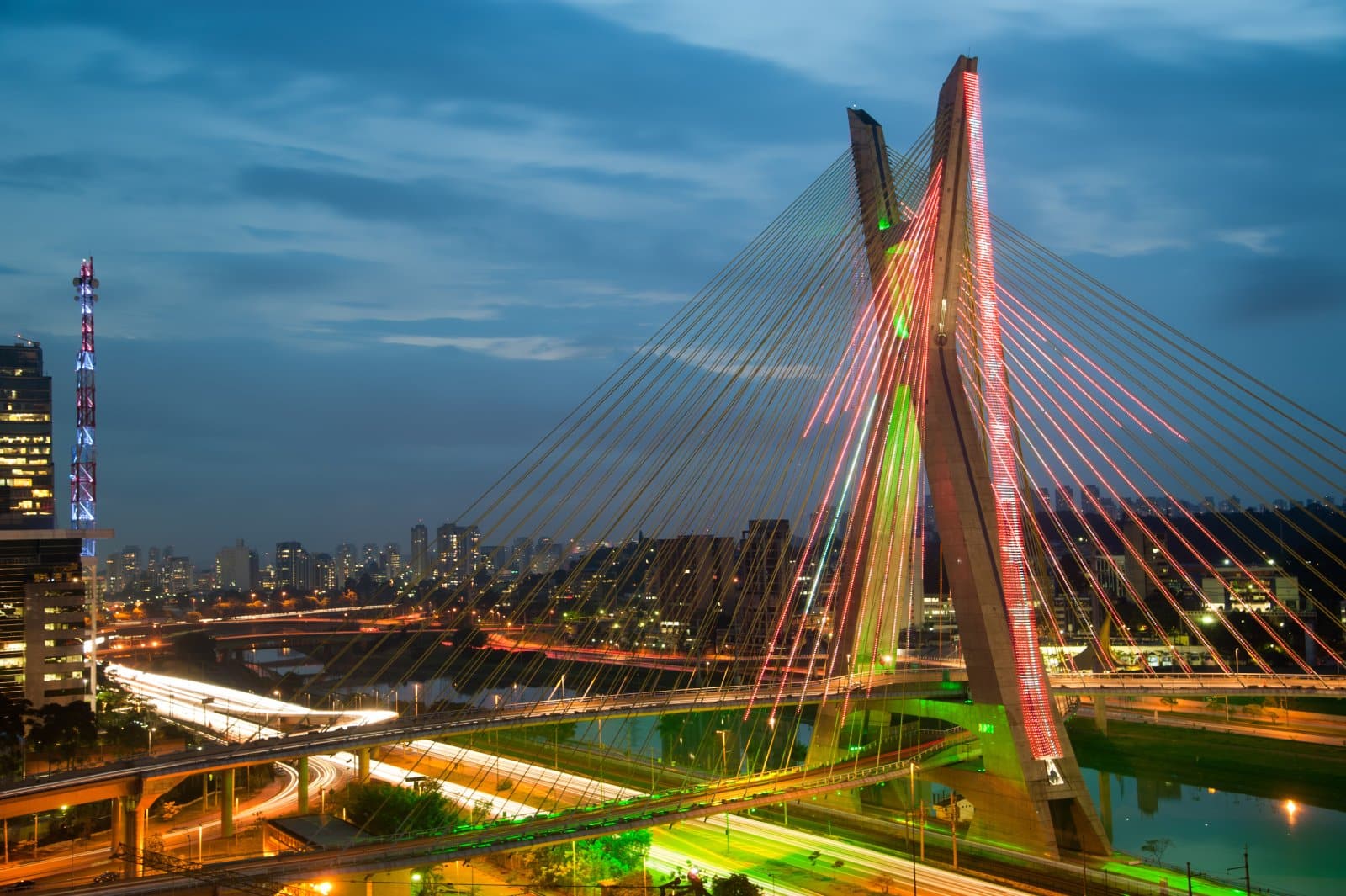
Considerations: Street safety, intentional homicide against women. Tips: Avoid walking alone at night and be cautious of personal belongings.

Considerations: Non-partner sexual violence, legal discrimination. Tips: Research local laws affecting women, travel in groups when possible.

Considerations: Street safety, non-partner sexual violence. Tips: Stick to tourist-friendly areas, stay aware of your surroundings.

Considerations: Global Gender Gap, legal discrimination. Tips: Dress conservatively, be aware of social customs.

6. Dominican Republic
Considerations: Street safety, recent mysterious incidents. Tips: Stay in reputable accommodations, use trusted transportation.
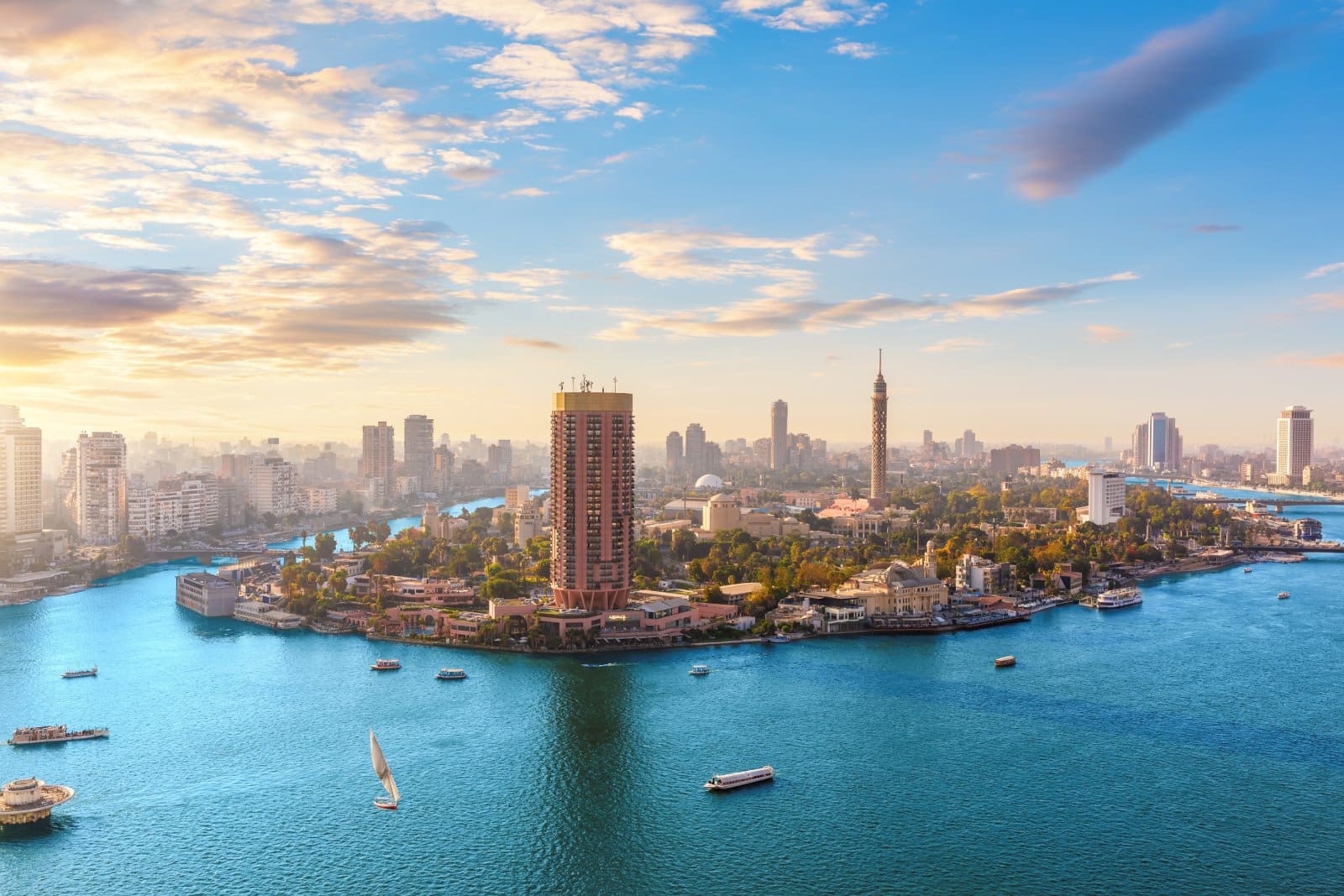
Considerations: Global gender gap, street safety. Tips: Join group tours for sightseeing, respect local dress codes.

Considerations: Intimate partner violence, street safety. Tips: Dress modestly, prefer organized group travel.

Considerations: Gender inequality, intimate partner violence. Tips: Use female-only transportation options where available, avoid traveling alone at night.

10. Thailand
Considerations: Violence against women attitudes, intimate partner violence. Tips: Keep personal belongings secure, choose accommodations wisely.

11. Malaysia
Considerations: Intimate partner violence, gender inequality. Tips: Research local customs and laws, stay in well-reviewed accommodations.

12. Saudi Arabia
Considerations: Legal discrimination, global gender gap. Tips: Understand and comply with dress codes, travel with a companion if possible.

Considerations: Intimate partner violence, global gender gap. Tips: Stay aware of social and political climates, consider cultural norms in behavior.
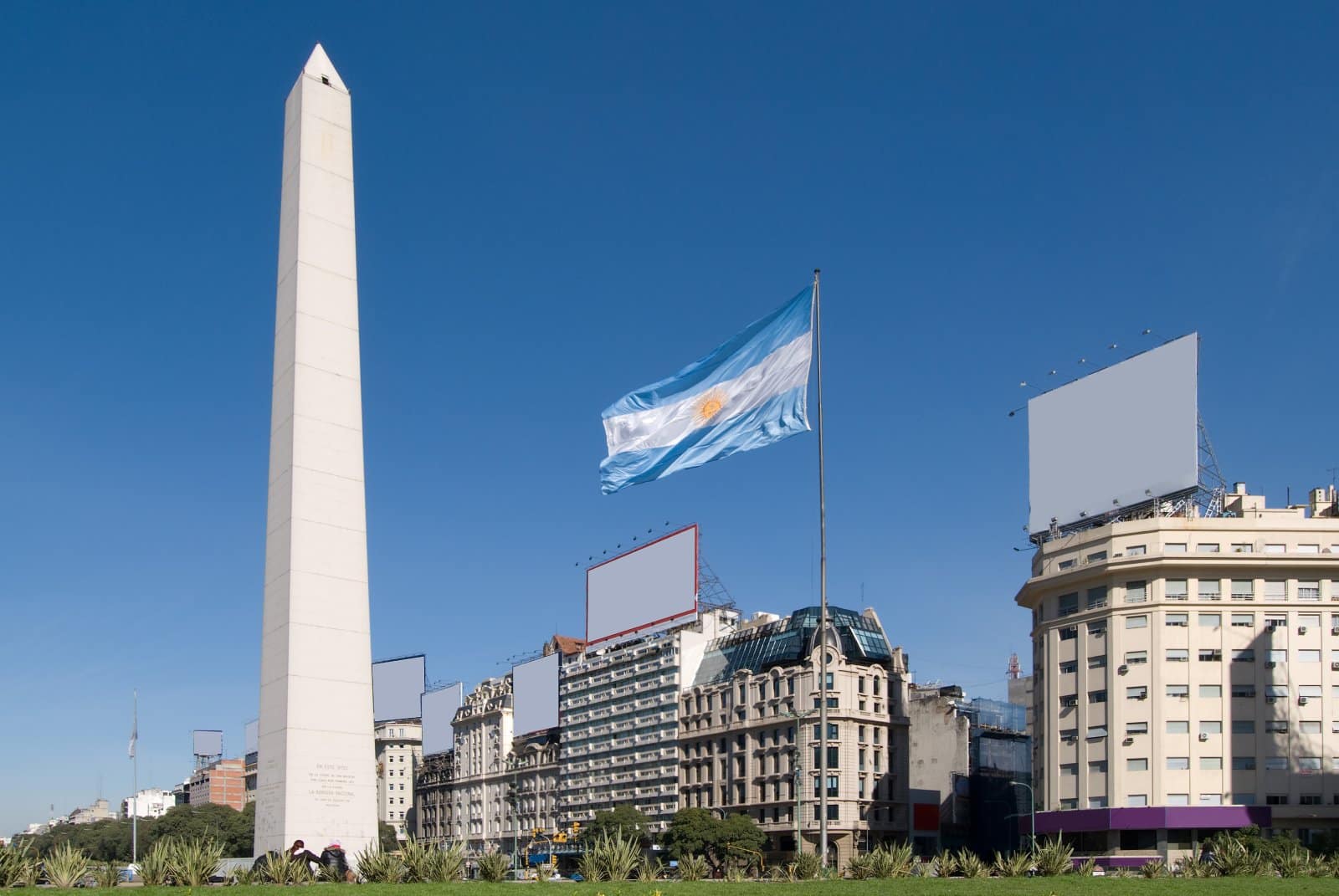
14. Argentina
Considerations: Street safety, intentional homicide against women. Tips: Use reputable taxi services, avoid less populated areas at night.

Considerations: Street safety, intimate partner violence. Tips: Be cautious with personal space and belongings, stay in groups during nightlife outings.

16. Cambodia
Considerations: Violence against women attitudes, global gender gap. Tips: Travel with companions, choose guided tours for exploration.

17. Bahrain
Considerations: Legal discrimination, global gender gap. Tips: Stay informed on rights and legal protections for women, travel in groups.

18. Tunisia
Considerations: Global gender gap, street safety. Tips: Dress conservatively, be aware of local customs and social norms.

19. United States
Considerations: Street safety, non-partner sexual violence. Tips: Stay in well-lit, populated areas at night, use apps to share your location with trusted contacts.

20. Ukraine
Considerations: Street safety, global gender gap. Tips: Be cautious when meeting new people, use trusted transportation services.
Traveling as a solo female offers a unique set of challenges, but with the right precautions and awareness, it can also be an incredibly rewarding experience. Always research your destination thoroughly, stay aware of your surroundings, and trust your instincts.

Budget Boss: 12 Tips for Managing Your Money Wisely
Embarking on a journey to master budgeting requires evidence-based strategies supported by research to manage your finances effectively and achieve your financial goals. Here are 12 research-backed tips, along with actionable steps to implement them, for mastering budgeting and maximizing your financial well-being. Budget Boss: 12 Tips for Managing Your Money Wisely

Ranking the Top and Bottom 24 U.S. Universities
Wondering which universities are the cream of the crop and which ones fall short of the mark? Today, we’re ranking the 24 best and worst universities in the United States to give you the inside scoop on higher education excellence and disappointment. Are you ready to uncover the highs and lows of academia? Ranking the Top and Bottom 24 U.S. Universities

The Path to Self-Discovery: 15 Steps to Finding Your True Self
Embarking on a journey of self-discovery goes beyond mere introspection; it requires actionable steps backed by research to uncover your authentic self. Here are 15 evidence-based strategies and practical steps to get started on each. The Path to Self-Discovery: 15 Steps to Finding Your True Self
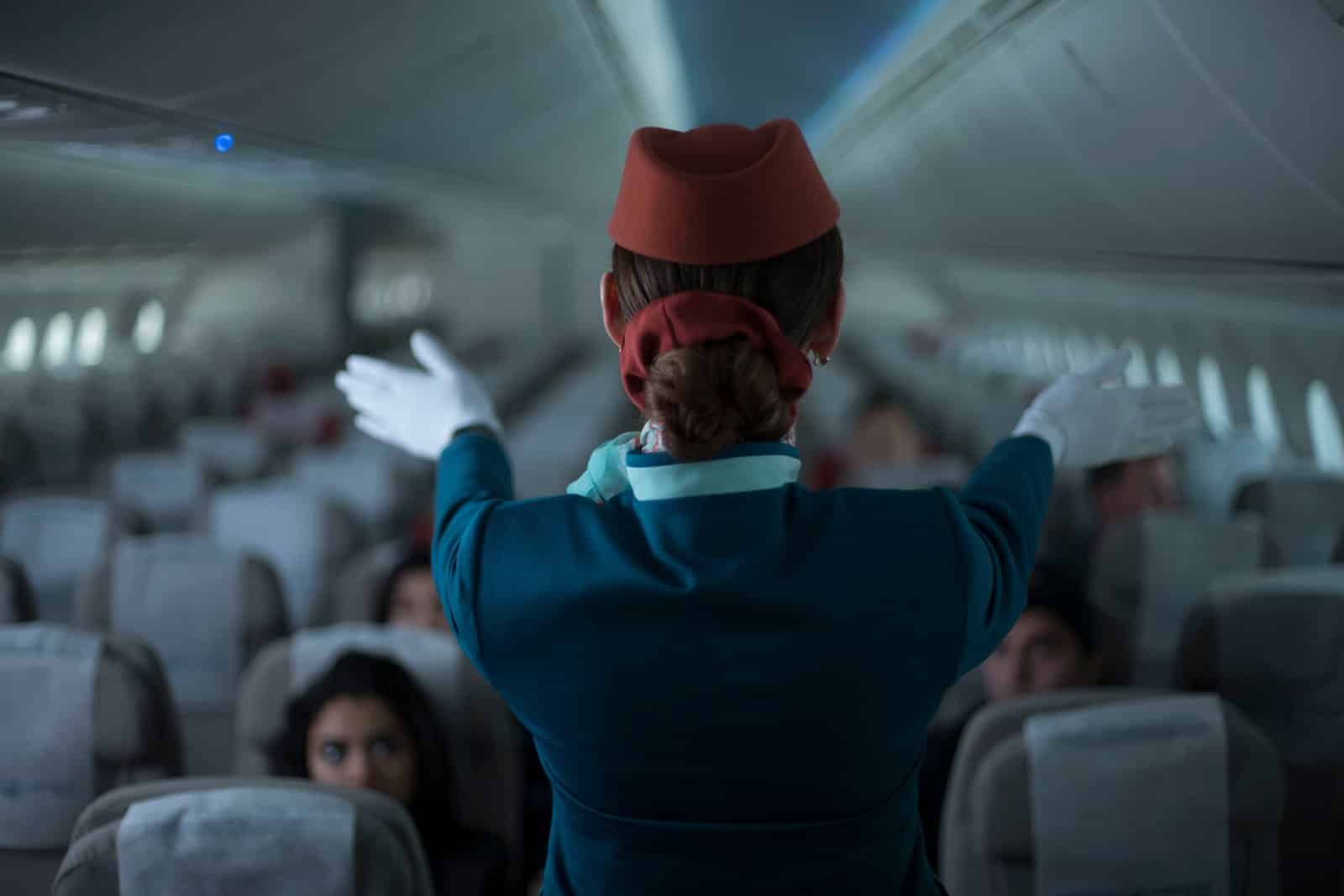
18 Trending Jobs That Let You Travel While Working
Dreaming of turning your wanderlust into a way of life? Believe it or not, there are careers that not only allow but encourage you to explore the globe, dive into new cultures, and collect experiences instead of things. Here are 18 unconventional jobs that offer just that, with a bit more insight into each. 18 Trending Jobs That Let You Travel While Working

Grow Every Day: 14 Habits for Tangible Personal Progress
Ready to take your personal growth journey to the next level? Incorporating small, tangible practices into your daily routine can lead to significant positive changes in your life. From expressing gratitude to nurturing connections with loved ones, these 14 daily habits are designed to empower you to thrive and flourish. Let’s dive in and elevate your life one day at a time! Grow Every Day: 14 Habits for Tangible Personal Progress
The post Warning Signs Ahead: 21 Travel Zones Single Women Should Skip first appeared on Not Your Boss Babe .
Featured Image Credit: Shutterstock / eldar nurkovic.
The content of this article is for informational purposes only and does not constitute or replace professional financial advice.
For transparency, this content was partly developed with AI assistance and carefully curated by an experienced editor to be informative and ensure accuracy.
More for You
Stephen Hawking once gave a simple answer as to whether there was a God
Childhood Classics or Cringe-Worthy? 18 Movies You Adored as a Kid but Now Find Utterly Ridiculous as an Adult!
Ron DeSantis Speaks Out On Donald Trump's Voting Rights
Jennifer Garner and Her Mom Demonstrate the ‘Grandmom Corn’ Recipe That Jennifer ‘Grew Up On’ and Her Kids Now Love
Insurance companies are monitoring homes from the sky, causing headache for some homeowners
The richest comedian in the world isn't Leno or Letterman, based on data. Here are the top 20.
The Common Household Ingredient That Can Unclog Slow-Draining Sinks And Tubs
14 arrested in largest child predator sting in Mooresville police history
7 Stephen King Books That Should Be Movies, Ranked
Michael J. Fox celebrates lookalike son Sam's birthday with rare photo and tribute
Be Careful: These Android Apps Are Installing Malware, Stealing Your Data
I'm Completely Smitten With Julia Child's Shredded Potato Gratin
Ukraine-Russia war – live: Putin faces rare protest as Kyiv fires first US weapon inside Russia
Trump's Fani Willis Case Handed New Court Date
2 things that aren't that great about retirement, according to retirees
Two popular restaurant chains consider bankruptcy, liquidation
Map reveals best places to live in the US if nuclear war breaks out
Yellowstone Spinoff, 1923, Gets Major Filming Update
14 Interesting Details In Early Drafts Of Beloved Movies
My mom had a trust, so why do we still need probate to settle her estate?
Dahlia Street bridge repair over I-76 in Commerce City beginning June 2
Travel advisory.
Commerce City — The Colorado Department of Transportation will begin repairs Sunday, June 2, on the Dahlia Street bridge over I-76. The project will repair damage that was caused when a tractor-trailer, towing construction equipment, struck the outer edge of the bridge last March.
The repair work will require overnight single lane closures on I-76 June 2 through early July and a 36-hour weekend full closure of westbound I-76 under the Dahlia Street bridge in late June. Northbound Dahlia Street bridge will continue to be closed during the project. The repairs should be complete in early July.
The project involves repairing the damaged bridge girders, other bridge reconstruction and repainting. The project will fully restore the bridge to its original form and reopen northbound Dahlia Street traffic over I-76, which has been restricted since March.
Travel Impacts
- Overnight single lane closures on I-76 beginning June 2 through early July. Weekday closures from 7 p.m. to 5 a.m. and weekend closures from 6 p.m. to 7 a.m.
- Continued closure of northbound Dahlia Street traffic over I-76
- A 36-hour weekend closure of westbound I-76 and Dahlia Street in late June
- The speed limit will be reduced through the work zone
- The project is expected to last until early July
- Motorists are urged to drive safely through the work zone, heed the speed limit, watch for construction crews, leave plenty of following distance and be patient
- Lane closure and project schedule could change depending on the weather. The latest lane closure information will be posted on COtrip.org
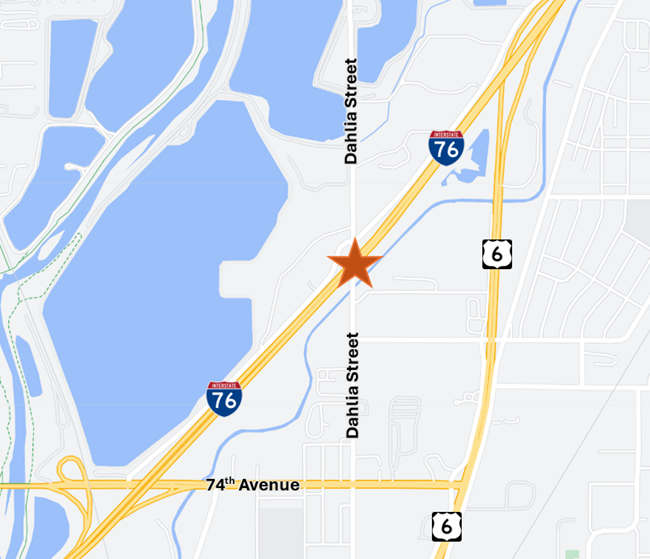
Project Information
- Webpage: I-76 & Dahlia Emergency Bridge Repair — Colorado Department of Transportation (codot.gov)
- Information hotline: (719) 800-2186
- Email: [email protected]
Know Before You Go
Travelers are urged to “know before you go.” Gather information about weather forecasts and anticipated travel impacts and current road conditions prior to hitting the road. CDOT resources include:
- Road conditions and travel information: COtrip.org
- Download the COtrip Planner app: bit.ly/COtripapp
- Sign up for project or travel alerts: bit.ly/COnewsalerts
- See scheduled construction lane closures: bit.ly/laneclosures
- Connect with @ColoradoDOT on social media: Twitter , Facebook , Instagram and YouTube
Remember: Slow For The Cone Zone
The following tips are to help you stay safe while traveling through maintenance and construction work zones.
- Do not speed in work zones. Obey the posted speed limits.
- Stay Alert! Expect the unexpected.
- Watch for workers. Drive with caution.
- Don't change lanes unnecessarily.
- Avoid using mobile devices such as phones while driving in work zones.
- Turn on headlights so that workers and other drivers can see you.
- Be especially alert at night while driving in work zones.
- Expect delays, especially during peak travel times.
- Allow ample space between you and the car in front of you.
- Anticipate lane shifts and merge when directed to do so.
- Be patient!
Download the COtrip App!
The new free COtrip Planner mobile app was designed to meet the growing trend of information on mobile and tablet devices for the traveling public. The COtrip Planner app provides statewide, real-time traffic information, and works on mobile devices that operate on the iOS and Android platforms. Visit the Google Play Store (Android devices) or the Apple Store (iOS devices) to download!
Affordable mobile data across Europe and beyond
Stay connected in 45+ countries in Europe with a single eSIM from Vodafone Travel.
Watch 60 second video
What is eSIM?
eSIM is a digital SIM that you can download. No plastic, no shop visits.It’s easier and greener. Install and get online in a matter of minutes!
Stay connected
Use the same eSIM across 45+ European countries and stay connected
Fast and easy
Get your Europe eSIM immediately via email, and connect within seconds
Wi-Fi Hotspot
Share your internet connection with friends, family, and any other devices
Keep your original SIM
Your existing SIM card will continue to operate, while the eSIM provides you data connectivity.
How it works
No more swapping SIM cards when you travel! Buy your eSIM before you go for faster, easier connectivity - wherever you roam.

Before purchasing, make sure that your device is eSIM compatible using our device compatibility tool.

Install your eSIM as soon as possible. You’ll need a stable internet connection. You can use another device to scan your QR code or install your eSIM manually.

Activate when you are ready to use the eSIM. You can do it in flight or upon arrival at your destination (you don’t need an internet connection to activate).
Join 300M+ global customers who choose Vodafone
A reliable, award-winning network. Choose eSIM from Europe’s most trusted Network provider and we’ll keep you connected to the things and people that matter.

Included Locations
Enjoy 4G/LTE and 5G coverage (where available) in the following countries and regions with our Europe eSIM Plan

United Kingdom

Frequently Asked Questions
Get in touch.
Can’t find the answers you’re looking for in our FAQs? Drop us an email and we’ll get back to you promptly.
- Terms & Conditions
- Privacy Policy
- Cookie Policy
- Charges Guide
- Acceptable Usage Policy
- eSIM Installation Guide
Vodafone Roaming Services S.à r.l. is registered in the Grand Duchy of Luxembourg. R.C.S Luxembourg No. B125883. Registered Office: 15 rue Edward Steichen, L-2540 Luxembourg, Grand Duchy of Luxembourg. VAT LU22869756
- Credit cards
- View all credit cards
- Banking guide
- Loans guide
- Insurance guide
- Personal finance
- View all personal finance
- Small business
- Small business guide
- View all taxes
You’re our first priority. Every time.
We believe everyone should be able to make financial decisions with confidence. And while our site doesn’t feature every company or financial product available on the market, we’re proud that the guidance we offer, the information we provide and the tools we create are objective, independent, straightforward — and free.
So how do we make money? Our partners compensate us. This may influence which products we review and write about (and where those products appear on the site), but it in no way affects our recommendations or advice, which are grounded in thousands of hours of research. Our partners cannot pay us to guarantee favorable reviews of their products or services. Here is a list of our partners .
The Guide to Single Trip Travel Insurance

Many or all of the products featured here are from our partners who compensate us. This influences which products we write about and where and how the product appears on a page. However, this does not influence our evaluations. Our opinions are our own. Here is a list of our partners and here's how we make money .
Table of Contents
How single trip travel insurance works
How to choose between travel insurance companies, best plans for single trip travel insurance, other tips for travel insurance for a single trip, travel cards that come with complimentary travel insurance, single travel insurance for a trip recapped.
There are many types of travel insurance, including plans that’ll reimburse you for emergency medical expenses or unexpected travel delays. Along with coverage types, there are also different durations of travel insurance.
Single trip travel insurance will cover you during one vacation, while multitrip or annual travel insurance can last for multiple outings. Let’s take a look at single trip travel insurance, what kind of coverage you can expect and how to choose a plan that works for you.
Purchasing a travel insurance plan is fairly simple, as is making a claim. It generally goes like this:
You gather a few quotes from travel insurance companies.
You pick a plan that suits your needs and customize it to your liking.
You purchase your plan and include a date for it to start.
You go on your trip.
If something happens (such as a flight delay), keep the proof.
You make a claim with your travel insurance company.
The travel insurance company reimburses you.
There are a few variations in how this can work (for instance, some travel insurance plans can pay a medical provider directly), but for the most part, this is how the process will go. This is the case whether you have one-trip travel insurance or multitrip travel insurance.
» Learn more: How to find the best travel insurance
There are several travel insurance companies out there, which can make choosing a plan difficult.
NerdWallet analysis found that some travel insurance providers rise above the rest in terms of breadth and depth of coverage, cost, customizability, and overall customer satisfaction. Jump to see our findings on the bets plans for single trip travel insurance.
However, before choosing a company and purchasing a plan, consider these questions:
How much am I willing to pay?
Do I want trip protection, emergency medical coverage or both?
Do I already have coverage somewhere?
How much customizability does my plan need?
Do I need coverage for preexisting conditions?
Will I be doing any sort of adventure activities?
Once you’ve answered these questions, do your due diligence and get quotes from multiple sources. Different providers will offer differing levels of coverage at varying prices, so it’s in your best interest to generate as many quotes as possible and read the fine print.
To make it simple, travel insurance aggregators such as Squaremouth (a NerdWallet partner) will provide you with multiple quotes at a time.
» Learn more: The best travel credit cards right now
We considered a wide variety of factors when it comes to selecting the best insurance for your trip. These factors include cost, customizability, coverage maximums, whether preexisting conditions are included and the type of coverage the policy offers.
World Nomads
World Nomads is great for active travelers because of its standard coverage of adventure activities. With just two plans from which to choose, it’s also simple to decide which one you’d like.
Covers 200-plus activities as standard.
Simple plan options.
Emergency medical coverage included.
Only two choices for policies.
Riskier activities are covered only by the more expensive Explorer plan.
Fixed-rate reimbursement for trip protection.
» Learn more: Read our full review of World Nomads
With eight plans on offer, Tin Leg has a policy for every type of traveler. Along with standard trip protections, Tin Leg also offers Cancel For Any Reason (CFAR) add-ons.
Plenty of plans from which to choose.
Preexisting conditions included in most plans.
Primary and secondary medical coverage options.
Cheapest plan doesn’t cover preexisting medical conditions.
Rental car coverage add-on available only on Luxury plan.
» Learn more: Is Cancel For Any Reason travel insurance worth it?
Seven Corners
Seven Corners is an excellent option for those who really want to customize their plans. Whether you’re looking for medical-only insurance or a more comprehensive policy, Seven Corners has options available.
Preexisting condition coverage available.
Medical-only plans on offer.
Covers missed tours and cruise connections.
Inexpensive plan offers secondary medical insurance.
Event ticket registration coverage only for expensive plan.
» Learn more: Is Seven Corners coverage worth the cost?
Our last company on the list is unique in that it covers those who use travel rewards, like purchasing flights or hotels with points and miles . This is fairly uncommon among travel insurance providers and can be really helpful when things go awry during award travel.
Plan options include accidental death and dismemberment (AD&D) travel life insurance.
Covers up to $300 in frequent traveler reward costs.
Worldwide travel assistance included on every policy.
Cancel For Any Reason insurance available only on most expensive plan.
Just $35,000 in emergency medical for basic plan (low compared to similar policies at other companies).
» Learn more: Our full TravelSafe review
If you’re interested in getting travel insurance, do yourself a favor and consider these tips before making any purchases:
Consult your medical insurance provider to see whether it offers coverage out of country .
Consider an annual plan to save money if you make multiple trips per year.
Check your credit card for complimentary travel insurance . Many offer this benefit, and if its limits are satisfactory, you can book your travels with it and avoid buying a separate policy out-of-pocket altogether. More on this in the next section.
If you're looking to get coverage for a one-off trip, among your best options is to simply pay for your travel with a card that includes travel insurance as a benefit.
Most travel cards will include coverage for things like trip interruption , trip delays and lost luggage .

on Chase's website

on American Express' website
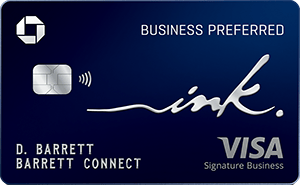
• Trip delay: Up to $500 per ticket for delays more than 12 hours.
• Trip cancellation: Up to $10,000 per person and $20,000 per trip. Maximum benefit of $40,000 per 12-month period.
• Trip interruption: Up to $10,000 per person and $20,000 per trip. Maximum benefit of $40,000 per 12-month period.
• Baggage delay: Up to $100 per day for five days.
• Lost luggage: Up to $3,000 per passenger.
• Trip delay: Up to $500 per ticket for delays more than 6 hours.
• Trip delay: Up to $500 per trip for delays more than 6 hours.
• Trip cancellation: Up to $10,000 per trip. Maximum benefit of $20,000 per 12-month period.
• Trip interruption: Up to $10,000 per trip. Maximum benefit of $20,000 per 12-month period.
Terms apply.
If you’re in the market for single trip travel insurance, there are plenty of options available to you. Before purchasing a plan, grab quotes from multiple companies because the types of coverage and costs are going to vary.
Beyond this, be sure to check whether your credit card offers complimentary travel insurance and reach out to your medical insurance provider to see what type of coverage it offers overseas.
American Express insurance disclosures
Insurance Benefit: Trip Delay Insurance
Up to $500 per Covered Trip that is delayed for more than 6 hours; and 2 claims per Eligible Card per 12 consecutive month period.
Eligibility and Benefit level varies by Card. Terms, Conditions and Limitations Apply.
Please visit americanexpress.com/benefitsguide for more details.
Underwritten by New Hampshire Insurance Company, an AIG Company.
Insurance Benefit: Trip Cancellation and Interruption Insurance
The maximum benefit amount for Trip Cancellation and Interruption Insurance is $10,000 per Covered Trip and $20,000 per Eligible Card per 12 consecutive month period.
Insurance Benefit: Baggage Insurance Plan
Baggage Insurance Plan coverage can be in effect for Covered Persons for eligible lost, damaged, or stolen Baggage during their travel on a Common Carrier Vehicle (e.g. plane, train, ship, or bus) when the Entire Fare for a ticket for the trip (one-way or round-trip) is charged to an Eligible Card. Coverage can be provided for up to $2,000 for checked Baggage and up to a combined maximum of $3,000 for checked and carry-on Baggage, in excess of coverage provided by the Common Carrier. The coverage is also subject to a $3,000 aggregate limit per Covered Trip. For New York State residents, there is a $2,000 per bag/suitcase limit for each Covered Person with a $10,000 aggregate maximum for all Covered Persons per Covered Trip.
Underwritten by AMEX Assurance Company.
How to maximize your rewards
You want a travel credit card that prioritizes what’s important to you. Here are some of the best travel credit cards of 2024 :
Flexibility, point transfers and a large bonus: Chase Sapphire Preferred® Card
No annual fee: Bank of America® Travel Rewards credit card
Flat-rate travel rewards: Capital One Venture Rewards Credit Card
Bonus travel rewards and high-end perks: Chase Sapphire Reserve®
Luxury perks: The Platinum Card® from American Express
Business travelers: Ink Business Preferred® Credit Card
1x-10x Earn 5x total points on flights and 10x total points on hotels and car rentals when you purchase travel through Chase Travel℠ immediately after the first $300 is spent on travel purchases annually. Earn 3x points on other travel and dining & 1 point per $1 spent on all other purchases.
75,000 Earn 75,000 bonus points after you spend $4,000 on purchases in the first 3 months from account opening. That's $1,125 toward travel when you redeem through Chase Travel℠.
1x-5x 5x on travel purchased through Chase Travel℠, 3x on dining, select streaming services and online groceries, 2x on all other travel purchases, 1x on all other purchases.
75,000 Earn 75,000 bonus points after you spend $4,000 on purchases in the first 3 months from account opening. That's over $900 when you redeem through Chase Travel℠.

1x-2x Earn 2X points on Southwest® purchases. Earn 2X points on local transit and commuting, including rideshare. Earn 2X points on internet, cable, and phone services, and select streaming. Earn 1X points on all other purchases.
50,000 Earn 50,000 bonus points after spending $1,000 on purchases in the first 3 months from account opening.


- Places to Visit
- Sightseeing
- Practical Tips
- Where to Stay
London Bus Tickets & Passes
Buses are the cheapest way to travel around London. There are no zones for bus travel — a single bus ticket is the same price whether your journey is in zone 1 or if you pass through several zones.
We list the options available to pay for single bus tickets or for unlimited bus travel for one day, one week or one month.
Single bus tickets: Oyster/contactless single bus fares 2024
London buses are ‘cashless’. You can’t buy a bus ticket on the bus.
To pay for travel by bus in London you need one of the following:
- a Pay as you go Oyster card
- a contactless credit or debit card
- One Day Bus & Tram Pass
- a weekly/monthly Bus Pass
- a paper One Day or Weekly Travelcard
- a weekly/monthly Travelcard loaded onto an Oyster card
Fare below are valid until the beginning of March 2025.
A single bus fare costs £1.75 with a Pay as you go Oyster card and contactless credit/debit card.
‘One Hour’ hopper fare
There is a ‘one-hour’ hopper fare for Pay as you go Oyster/contactless card users. You can take as many bus journeys as you want in a one-hour period for £1.75 .
The hopper fare also applies if you use the tube or train between your bus journeys.
One day bus travel: Oyster/contactless daily bus fares 2024
Bus ‘daily cap’.
When you use a Pay as you go Oyster or a contactless card to pay for bus travel, there’s a ‘daily cap’.
This is the maximum amount deducted from your card for unlimited travel by bus in London in one day. If you make 3 or more bus trips*, £5.25 is taken from your Oyster/contactless card.
How does the ‘daily cap’ for buses work?
- If you make 1 bus trip*, £1.75 is deducted from your card
- If you make 2 trips, £3.50 is deducted
- If you make 3 trips, £5.25 is deducted from your Oyster card
- Your 4th trip and all other trips you make until 4.30am the following morning are free.
* a ‘bus trip’ means either a single trip on a bus or an unlimited amount of bus trips in a one hour period.
There’s no peak or off-peak rate for the bus ‘daily cap’; you can travel around the whole of London between 4.30am until 4.29am the following day for the same price.
One day bus pass
If you don’t want to use an Oyster card and don’t have a contactless card, you can buy a One Day Bus Pass for £5.90 .
- This is a paper ticket giving you unlimited bus travel until 4.29am the following day.
- Available from all underground station ticket machines, Oyster ticket stops , London Overground ticket offices, train station ticket offices and Transport for London Visitor Centres .
Weekly bus pass 2024
If you are visiting London for 5, 6 or 7 days and only use buses, a one-week bus pass costs £24.70 .
- The pass entitles you to unlimited travel on buses all over London within zones 1–6.
- The pass can start on any day of the week and is valid for travel at any time within the dates specified.
- Weekly bus passes are loaded onto an Oyster card ( £7 fee).
Compared to the cost of a weekly Travelcard , it’s good value.
Weekly bus cap with an Oyster card 2024
If you have an Oyster card, bus fares are capped from Monday to Sunday (the same as contactless cards ). This means you will not pay more than £24.70 , the cost of the standard weekly bus pass.
The fares are calculated from Monday to Sunday, so it mainly benefits people living and working in London rather than visitors.
If you plan to visit London for seven days and first use the buses on Thursday, Friday, Saturday or Sunday buy an ordinary weekly bus pass instead.
Monthly bus pass 2024
A one month bus pass is £94.90 .
There’s not a huge saving compared to buying 4 x weekly passes, but it saves remembering to renew.
Monthly bus passes are loaded onto an Oyster card.
Where to buy a weekly or monthly bus passes
Underground station ticket machines.
Weekly or monthly bus passes are available from underground station ticket machines.
Oyster Ticket Stops
Oyster Ticket Stops are newsagents and local shops that sell London transport passes and Oyster cards. Find your nearest Oyster Ticket Stop .
Transport for London Visitor Centres
Transport for London Visitor Centres at Victoria, Heathrow, Piccadilly Circus, Liverpool St and King’s Cross & St Pancras International.
Other bus ticket info
Are travelcards valid on buses.
Yes, one day, weekly or monthly Travelcards are valid on London buses. Travelcards valid for any zone can be used to ride the buses all over London. For example, if you have a zone 2-3 weekly or monthly Travelcard you can use it to travel on buses in zone 1 (central London).
Single bus fares for children
All children aged 10 and under travel for free on London buses. See child tickets & passes for bus fare information for older children.
Bus Saver tickets
These are no longer available to buy. If you have a Bus Saver ticket, it is still valid. Just show it to the bus driver when boarding the bus.
‘One more journey’ feature
If you don’t have £1.75 on your Oyster, you can still use it to pay for a bus trip as long as you have between 1p–£1.75 credit on your Oyster card. The next time you top-up your card, you need to clear the negative balance before it can be used again.
Related pages
- Guide to London’s transport tickets
- How to get around by bus
- Sightseeing by local buses
- Child tickets and passes
Back to top
Last checked: 21 February 2024
Transport tickets & passes
- Guide to London's transport tickets
- One day & weekly Travelcards
- Zone 2–6 weekly Travelcards
- Bus tickets & passes
- Oyster card
- Oyster single tickets
- Oyster card refunds
- Contactless cards
- Child tickets & passes
- Local train tickets
Useful information
- Plan your journey
- London transport zones
Popular pages
- Left luggage offices
- Congestion Charge
- 2 for 1 discounts at London attractions
- Oyster cards
- Top free museums & galleries
- Cheap eating tips
- Heathrow to London by underground
Copyright 2010-2024 toptiplondon.com. All rights reserved. Contact us | Disclaimer | Privacy

7 Best Cruises for Singles in 2024
Updated : May 29, 2024
AAA Travel Editors
Table of contents.
- Celebrity Millennium: Bali, Malaysia and Thailand
- Celebrity Apex: Norwegian Fjords
- Celebrity Summit: Grand Heartland Adventure
- Celebrity Edge: Taste of Luxury
- Disney Wish: Bahamian Cruise from Port Canaveral
- Oceania Cruises: In the Path of Cartier — Boston to Montreal
- Oceania Riviera: Ancient World Wonders — Athens to Istanbul
Plan Your Cruise With AAA
With many cruise lines now catering to the single crowd, going on a cruise as a single adult can be a great way to meet interesting people to make new friends, new connections and lifelong memories.
No matter what you envision from your dream singles cruise, you can find a ship and a series of destinations that will create unforgettable memories. There are a lot of options to explore, however and the sheer range of choices can quickly feel overwhelming. To help, we've highlighted several of the best cruises for singles. Keep reading to learn what, exactly, sets these expeditions apart.
1. Celebrity Millennium: Bali, Malaysia and Thailand
Many singles gravitate towards exciting adventures in exotic destinations such as Bali, Malaysia and Thailand, which hold appeal simply because they provide such distinct scenery and such powerful cultural experiences.
Not all singles are willing or prepared to navigate these destinations on their own, however and this is where the Celebrity Millennium comes into play: an upscale cruise removes the hassle of planning and, instead, encourages you to relax in style.
This particular Celebrity Millennium adventure spans nearly two weeks, incorporating a unique blend of serene island adventures, cosmopolitan exploration and meaningful temple visits. Onboard, globally inspired menus and resort-style lounges are to be expected, along with plenty of adults-only spaces that will appeal to singles.
2. Celebrity Apex: Norwegian Fjords
If Norway's iconic fjords are on your bucket list, you can't afford to miss this awe-inspiring Celebrity Apex trip . Departing from Southampton, the eight-night cruise meanders along the coast of Norway, hitting pleasant spots such as Geiranger or Kristiansand for spectacular scenery and outdoor adventures. Side trips are available and, with up to ten hours docked, there is plenty of time to explore at your own pace.
Accommodation options abound and, when traveling alone, the staterooms' king-size mattresses feel extra spacious. An adults-only solarium will appeal to relaxation-oriented solo travelers, while abundant dining and entertainment options make it easy to find and connect with new friends.
3. Celebrity Summit: Grand Heartland Adventure
If you're struggling to choose between glamorous onboard experiences and outdoorsy experiences on land, you're in luck: Celebrity Summit provides the best of both worlds with its various Cruisetour offerings. There are many excellent options that depart from Vancouver, Anchorage or Fairbanks — but the Grand Heartland Adventure is worth considering if you crave something new.
During the Grand Heartland Cruisetour, you'll explore the stunning Inside Passage by cruise ship, before docking in adventure-oriented destinations such as Juneau and Sitka. From there, you'll continue to observe national treasures such as the Hubbard Glacier. Further exploration takes place aboard a glass-domed railcar and even a riverboat.
There's also a lot to experience onboard. The AquaClass stateroom represents a true oasis for single travelers, but the exclusive cocktail lounge and martini bar also warrant a visit. With nearly two weeks of cruising and exploration, you'll have plenty of time to unwind on your own but can also form fast friendships with similarly adventurous travelers.
4. Celebrity Edge: Taste of Luxury
Cruises for singles over 50 often emphasize the finer things in life, like elevated cuisine or exquisite wines. These sophisticated details are in abundant supply aboard the Celebrity Edge, which offers a decidedly elegant experience with its Taste of Luxury tour. Although often frequented by retired couples, Celebrity Edge's trips work well as singles cruises.
Available for three or four nights, this remarkable journey begins in Sydney and primarily emphasizes curated on-board experiences. That being said, there are enticing opportunities to explore while docked in Tasmania. With such glamorous suites, restaurants and clubs on board, however, the best attractions can be enjoyed without ever leaving this luxury cruise ship.
5. Disney Wish: Bahamian Cruise from Port Canaveral
Don't assume that Disney cruise adventures are only for kids or families. If you are a proud Disney adult, you can make amazing memories aboard a thematic cruise for singles. This is a popular vacation among theme park enthusiasts, who enjoy a dose of Disney magic while also finding valuable opportunities to indulge and relax.
Disney Wish's three-night Bahamian cruise is also an excellent option for singles who crave a sea-based experience but only have a few days to spare. Yes, young travelers will be around, but there are plenty of adult-only spaces, including sports bars, dance clubs, dedicated pools and even an onboard spa and salon. Musicals, 3D films and fireworks encourage you to embrace your inner child.
6. Oceania Cruises: In the Path of Cartier — Boston to Montreal
As we've mentioned, smaller ships provide some of the best cruises for singles over 50. Not everyone desires a river-based trip, however and with Oceania Cruises , there is no need to choose between exclusivity and ocean liner grandeur.
A signature experience can be found aboard Oceania Cruises' iconic Nautica ship, which is calming, yet elegant. Echoing the journey of the famed explorer Jacques Cartier, this tour provides a powerful introduction to Quebec, Nova Scotia, Newfoundland and New Brunswick.
The land-based excursions are highly educational and, of course, beautiful to behold, but there's also a lot to love on board. Belgian chocolate, Bulgari amenities and turndown service await, with many accommodations also providing spectacular views. Open-seating dining makes it easy to interact with other vacationers while wine-tasting and guest lectures promise plenty of onboard enrichment.
7. Oceania Riviera: Ancient World Wonders — Athens to Istanbul
Another appealing option for singles who prefer slightly smaller ships, Oceania Cruises' Ancient World Wonders tour provides stops at some of the world's most iconic locations, such as Santorini and Corfu. Adventures in Dubrovnik and Istanbul can also be expected. On board this remarkable vessel, you'll gaze in awe at the Lalique Grand Staircase and, in general, enjoy a refined ambiance.
Be prepared to try new flavors and forms of expression as you explore unique offerings such as the Artist Loft and Culinary Center. Deep relaxation awaits at the Aquamar Spa or within your luxuriously contemporary stateroom or suite. This ten-night voyage provides plenty of time to lose yourself in the grandeur of the ship and the treasures of Greece, Montenegro, Croatia and Turkey.
Join the over a million people who are AAA members and start planning your cruise today. Dream up the perfect trip with our Trip Canvas research tool and use your membership to get the best discounts on hotels , rental cars and entertainment tickets.
More Articles
Travel like an expert with aaa and trip canvas, get ideas from the pros.
As one of the largest travel agencies in North America, we have a wealth of recommendations to share! Browse our articles and videos for inspiration, or dive right in with preplanned AAA Road Trips, cruises and vacation tours.
Build and Research Your Options
Save and organize every aspect of your trip including cruises, hotels, activities, transportation and more. Book hotels confidently using our AAA Diamond Designations and verified reviews.
Book Everything in One Place
From cruises to day tours, buy all parts of your vacation in one transaction, or work with our nationwide network of AAA Travel Agents to secure the trip of your dreams!
Predators aren't waiting to eat you in Tasmania: 7 things travelers should know
- Tasmania is an island off the southern coast of Australia.
- The island is known for its pristine wilderness, rugged coastlines and captivating wildlife.
- American travelers will find themselves instantly at ease in Tasmania, but don't be fooled – the island's allure lies in its ability to surprise and inspire with breathtaking sights.
The U.S. is teeming with beautiful landscapes, but there's something to be said about experiencing the power of nature halfway across the world.
Embarking on a journey to Tasmania, Australia, is like stepping into a realm where the familiar meets the extraordinary. For first-time visitors looking to start ticking bucket list destinations, Tasmania offers a unique blend of comfort and adventure – with a welcoming g'day. Nestled off the southern coast of the mainland, Tasmania boasts pristine wilderness, rugged coastlines and captivating wildlife.
Move over Hawaii, The Azores Islands also bring vibrant beauty (with fewer crowds)
With English as the primary language and a culture of warmth and hospitality, American travelers will find themselves instantly at ease. But don't be fooled, the island's allure lies in its breathtaking sights.
From exploring ancient rainforests to indulging in culinary surprises, Tasmania promises an unforgettable escape. I visited the island for the first time in May, the start of Australia's winter, and my jaw was on the floor most of the time there. Here's what you need to know before planning your own trip to Tassie.
1. The flights are exactly what you'd expect
There are no direct flights from the U.S. to Tasmania. You'll have to connect through Sydney or Melbourne to Launceston or Hobart. I went from Washington, D.C., to San Francisco to Melbourne to Launceston. It was terrible, I'm not going to lie. Next time I go, I'll spend a day on the West Coast before taking the U.S.-Australia 14-hour flight.
My recommendation is to take a red-eye flight to Australia and use it to sleep and switch over time zones.
Flight availability from the U.S. to Melbourne and Sydney (to transfer to Tasmania) is plentiful, with several major airlines offering regular routes. Travelers can choose from direct flights departing from major U.S. cities like Los Angeles, San Francisco, Houston, Dallas and even New York (with direct service to Auckland). Airlines such as United, American, Delta, Hawaiian, Qantas and Air New Zealand provide nonstop services.
(New direct service from Dallas to Brisbane via American Airlines is expected to launch in October, and from Los Angeles to Brisbane via Delta in December.)
How to visit Australia without flying: Holland America launches new Grand Voyage
2. Americans need a visa to enter the country
American travelers should be aware of the visa requirements before heading down under.
U.S. citizens need an Electronic Travel Authority (ETA) or an eVisitor visa, which can be easily obtained online before departure.
The process is straightforward, typically requiring basic personal information and a valid passport. Once approved, the visa allows for multiple entries into Australia for up to 90 days at a time over a 12-month period. I downloaded the Australian ETA app ( iOS and Android ), filled out a quick application, and my visa was granted in less than an hour.
3. Don't fret about the time zone difference
There's a 14-hour time difference from the U.S. East Coast. It sounds complicated but just embrace it.
The unique advantage of Tasmania’s 14-hour time difference is that you can truly disconnect and savor your vacation. The time zones down under can offer the perfect balance of relaxation and connectivity. Travelers can immerse themselves in the serene landscapes and vibrant culture during the day while still having a few hours in the morning and evening to connect with loved ones back home. It’s the ideal scenario for those seeking to unwind without completely losing touch.
4. Connection with nature
Travelers can immerse themselves in Tasmania's breathtaking nature through a variety of experiences.
At Cradle Mountain in Lake St. Clair National Park, visitors can hike rugged trails and take in stunning alpine views. If you visit at night, you can enjoy a view of cute wildlife with McDermotts Coaches .
But it's OK if you don't enjoy hiking. For a unique adventure, truffle hunting with The Truffle Farm in Deloraine offers another way to explore the island's culinary practices. Wine enthusiasts can savor the flavors of Tasmania at the Clover Hill winery in Lebrina, known for its exquisite sparkling wines and picturesque vineyards.
Whether it's trekking through pristine landscapes, foraging for gourmet treats, or indulging in fine wines, Tasmania offers something for every nature lover.
5. Nothing is likely to kill you
We've all seen social media videos of Australians battling snakes or large spiders, but you can relax.
Fear of wildlife often looms large for travelers, but Tasmania is free of large predators, making it a haven for nature enthusiasts. Here, you can explore lush forests and pristine coastlines without the fear of being eaten.
Tasmania’s unique ecosystem is home to creatures like Tasmanian devils (which are incredibly rare to spot – I also didn't), puggles, platypuses, pademelons, wombats and wallabies, ensuring a safe and enriching experience for all visitors.
There are three kinds of snakes in Tasmania and while two of them can be dangerous to humans, it is extremely rare to encounter them, according to Tourism Australia.
6. The food scene has something for everyone
You will not go hungry in Tasmania. Far from it.
Tasmania's food scene is a vibrant tapestry of flavors, reflecting the island's culinary influences. From fresh seafood caught in pristine waters to farm-to-table produce, there's something for every palate. Influences from British, Mediterranean, and Asian cuisines converge, creating a unique gastronomic experience. Visitors can savor everything from gourmet dining in Hobart’s top restaurants to artisanal cheese and local wine in countryside eateries.
The coffee scene deserves a special mention. The great people of Melbourne will claim they have the best coffee in the world, but Tasmania is right there with them.
Make a stop at Tatler Lane by Sweetbrew in Launceston for a perfect cup, delicious food and a great ambiance.
7. Easy access to a different side of the world
Once in Australia, travelers can take advantage of affordable flights to explore the continent and beyond.
Budget airlines offer frequent, low-cost flights to other Australian cities. This opens up opportunities for reasonably priced trips to exciting neighboring destinations such as Bali, Japan, Fiji or New Zealand. These nearby countries are just a few hours away by plane, so you can expand your adventure without breaking the bank.
Embrace the chance to explore more of the Asia-Pacific region with convenient and cost-effective travel options.
The reporter on this story received access to this event from Tourism Australia. USA TODAY maintains editorial control of content.
The Key Points at the top of this article were created with the assistance of Artificial Intelligence (AI) and reviewed by a journalist before publication. No other parts of the article were generated using AI. Learn more .

IMAGES
VIDEO
COMMENTS
Single fare finder. Find the cost of a journey between any two stations on Tube, DLR, London Overground, Elizabeth line and National Rail services where pay as you go (contactless or Oyster) is accepted. Fares between two stations may vary depending on the direction of travel, time of day and day of the week. Single fare finder only shows the ...
You can buy a single and return ticket if you don't travel regularly, you're making a one-off journey, or want the ticket for expenses. However, it's cheaper to pay as you go for your travel using contactless (card or device) or an Oyster card. For expenses, it's easy to use an Oyster and contactless account.
Using pay as you go. On Tube, DLR, London Overground, Elizabeth line and National Rail services in London: Peak fares - Monday to Friday (not on public holidays) between 06:30 and 09:30, and between 16:00 and 19:00. Off-peak fares - at all other times and if you travel from a station outside Zone 1 to a station in Zone 1 between 16:00 and 19:00 ...
For example, if you have a zone 1-2 weekly Travelcard and want to go to Richmond in zone 4, you need to pay for travel in zones 3-4. This is either £1.90 or £2.10 depending on the time of day you travel. To find single fares for a local London train journey or for a journey that includes a train, use TfL's Single Fare Finder instead. Single ...
See single ticket prices for travel in zones 2,3,4,5 & 6. Oyster single fares: peak and off-peak times. If you use your Pay as you go Oyster card only few times a day, the price you pay for each single journey depends on the time of day you travel. Off-peak fares apply on Fridays from 8 March until 31 May 2024. Peak
The authorities penalise you heavily for buying single journey tickets. In the centre you can pay more than double the price than if you used an Oyster Card for example. ... ~ Children's fares (11-15 yrs old) on Oyster for any trip within zones 1 to 6 are £1.70 off peak, between £4.05 - £7.45 peak * Peak fares apply Monday to Friday between ...
For travel in zone 1-2: Single tickets on the underground cost £2.80 with an Oyster card/contactless card. If you buy a ticket from a ticket machine, the full cash fare is £6.70. If you use your card to pay for transport in central London for the whole day, the 'daily cap' - the maximum amount deducted is £8.50.
Children aged 10 and under travel free when travelling with an adult paying the regular fare. How much does a one-day travelcard cost? One day travelcards are issued as paper tickets and cost £12.30 (zone 1-4). Day Travelcards aren't available on Oyster - but the Oyster Card daily capping is always better value than buying a Day Travelcard.
Travel time on the Tube is roughly 45 minutes to central London. Piccadilly line trains run out of Heathrow from 5:00 to 23:00. Ticket prices from Zone 1 to Heathrow are £6.70 for a cash-bought paper ticket, £5.60 on an Oyster card or contactless card at any time.
Imagine that you're travelling around zones 1-2 for a week, but you need to make a single journey into zone 6 for Heathrow airport. Buying a zone 1-6 weekly travelcard would be a waste of money just for a single trip, so you're better off buying a travelcard for zones 1-2 and then loading on some extra pay-as-you-go credit on to cover it ...
Single trip European breakdown covers you for a one-off return trip to Europe. With RAC cover, whether it's a quick day trip or an extended 90-day stay, ... These countries are split into Zone 1, Zone 2 and Zone 3, so you can easily select the right cover for you and your trip.
Under Myki, the concession which allows single (one-way) ticket holders one hour's free travel in Zones 1 & 2 either side of their V/Line journey, and free Zone 1 & 2 travel all day for all other ticket types, including day return, continues to apply. Myki users must still touch on and off where required, but the Myki system will not charge ...
2 hour Zone 1+2. $5.30. Concession. 2 hour Zone 1+2. $2.65. Bus. Full fare. 2 hour myki money fare between where a customer boards and the zone at the end of the service. All zones between and including the zone where the customer touches on and the zone at the end of the service.
1. Oyster capping is a complicated beast, but I think I have an answer for you. There are two caps - Anytime and Off Peak. Anytime for your card is set at £6.60 for Zones 1-2. Off Peak for your card is set at £4.35 for Zones 1-2. Journeys are tallied against the running totals of all applicable caps, so all journeys are tallied against the ...
The adult off-peak pay as you go fare for a journey in Zone 1 will be frozen at £2.70; The adult off-peak pay as you go fare in a single zone (not Zone 1) will be frozen at £1.80; Cash fares, also known as paper single tickets, for Zones 1-6 will be frozen at £6.70 where TfL fares apply.
SkyTrain requires a 1, 2, or 3-Zone fare, depending on the time and day* and number of zone boundaries you cross during your trip. SeaBus requires a 1 or 2-Zone fare, depending on the time and day* *All journeys across the system starting after 6:30 p.m. weekdays and all travel on weekends (Saturday, Sunday, and holidays) are a 1-Zone fare. A ...
£6.70 for one journey in zone 1 (central London) and between zone 1 and zones 2 to 6; See single ticket prices for all zones. One Day Travelcards: 2024 prices. Using a Pay as you go Oyster card or a contactless card are the cheapest ways to pay for travel if you're in London for 1-5 days. The daily cap is £8.50 per day for zones 1-2
Regional zones include: Zone 1+2, but only if you're travelling to or from a regional station or stop. Zones 3 to 15/16. the zone boundary overlap between any two consecutive zones. To find out which zone your station or stop is in, visit Regional myki zones. Fares are based on the number of zones you travel through, whether the travel is to ...
Zones 1-3. Zones 1-3 include the majority of major tourist attractions in Paris. Most visitors will never even leave zone 1. Here you'll find most hotels as well as the Eiffel Tower, the Louvre ...
Europe's leading train and coach app. We help customers across Europe make more than 172,000 smarter journeys every day. Travel by train from London Underground Zone 1-2 to London in 0m. Compare prices, view live journey times & book cheap train tickets for London Underground Zone 1-2 to London.
Traveling solo as a woman presents unique challenges but also offers unparalleled opportunities for growth, adventure, and self-discovery. Based on a variety of factors, including street safety ...
While Viking doesn't have single cabins, they will occasionally offer special solo traveler fares. Plus, you can check for other discounts available for the cruises you're interested in to save money on your travels. Book Now. 7. Seabourn Cruise Line. Single cabins: No. Solo travel perks: Special offers for solo travelers on select voyages
Travel Impacts. Overnight single lane closures on I-76 beginning June 2 through early July. Weekday closures from 7 p.m. to 5 a.m. and weekend closures from 6 p.m. to 7 a.m. ... Motorists are urged to drive safely through the work zone, heed the speed limit, watch for construction crews, leave plenty of following distance and be patient;
Buy your Vodafone Travel eSIM, install it quickly and enjoy our fast internet in Europe. eSIM Store. Blog. Help ... Help. Affordable mobile data across Europe and beyond. Stay connected in 45+ countries in Europe with a single eSIM from Vodafone Travel. Select Product. Watch 60 second video. What is eSIM? eSIM is a digital SIM that you can ...
Baggage Insurance Plan coverage can be in effect for Covered Persons for eligible lost, damaged, or stolen Baggage during their travel on a Common Carrier Vehicle (e.g. plane, train, ship, or bus ...
If you are visiting London for 5, 6 or 7 days and only use buses, a one-week bus pass costs £24.70. The pass entitles you to unlimited travel on buses all over London within zones 1-6. The pass can start on any day of the week and is valid for travel at any time within the dates specified. Weekly bus passes are loaded onto an Oyster card ...
2. Celebrity Apex: Norwegian Fjords. If Norway's iconic fjords are on your bucket list, you can't afford to miss this awe-inspiring Celebrity Apex trip. Departing from Southampton, the eight-night cruise meanders along the coast of Norway, hitting pleasant spots such as Geiranger or Kristiansand for spectacular scenery and outdoor adventures.
Single fare finder. Check the cost of a single journey between two stations. Find fares. Check the cost of your journey before you travel. Free and discounted travel. You may be eligible for free travel or discounts off your fares. How to pay and where to buy. There are different ways to pay for your travel. Contactless pay as you go.
2. Americans need a visa to enter the country. American travelers should be aware of the visa requirements before heading down under. U.S. citizens need an Electronic Travel Authority (ETA) or an ...